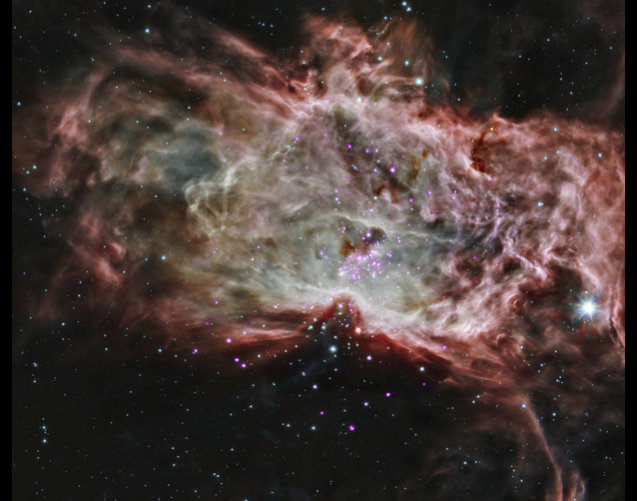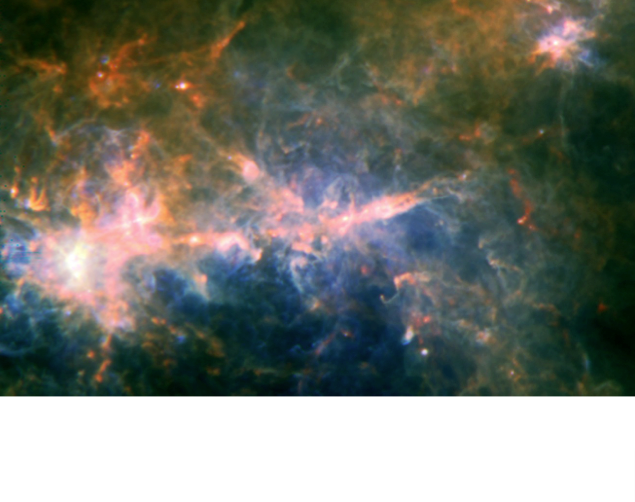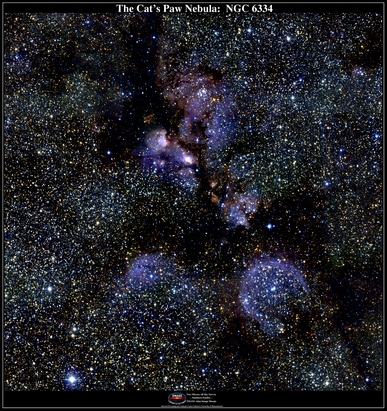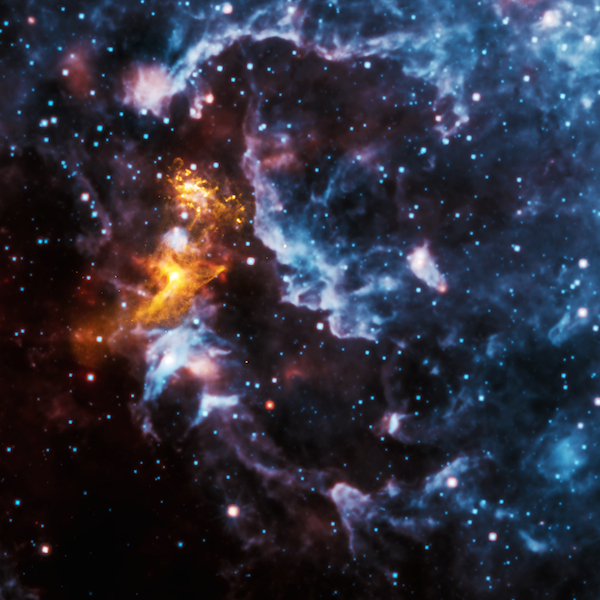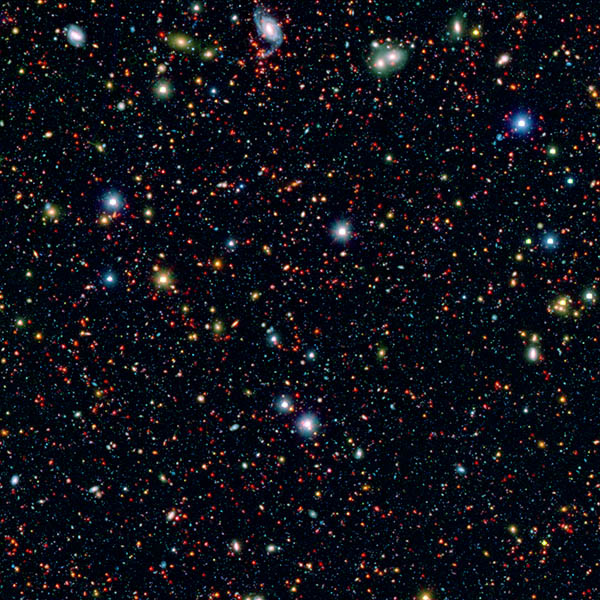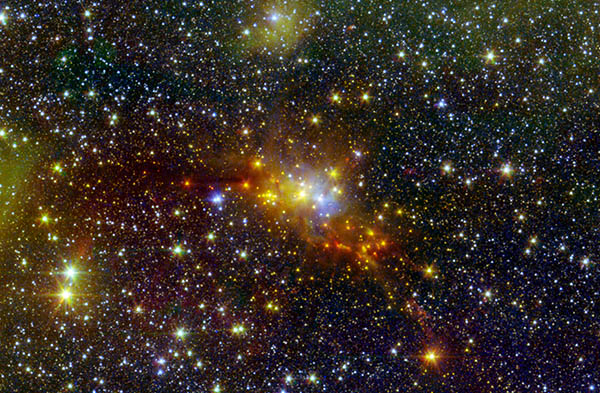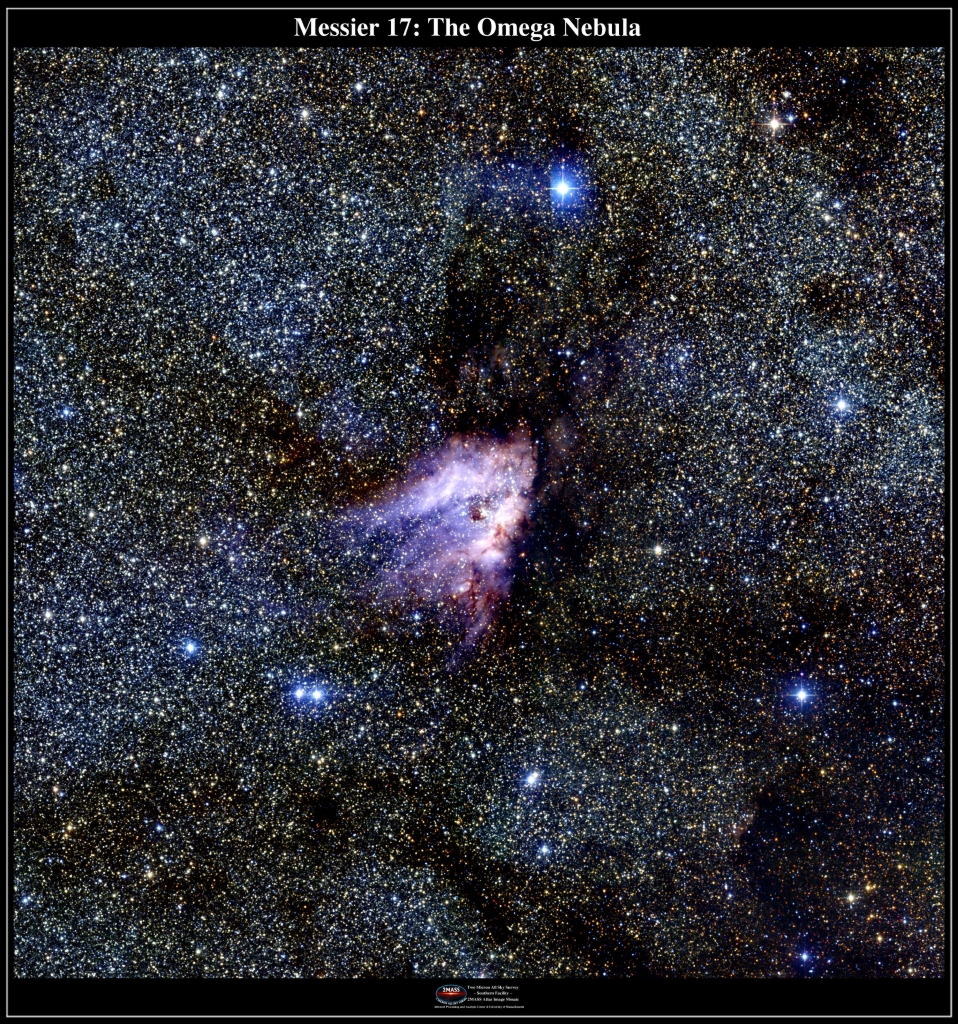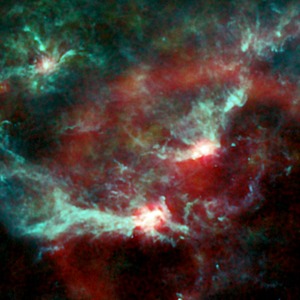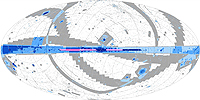IRSA Featured Images

|
This image of the Crab Nebula combines data from five different telescopes: the VLA (radio) in red; Spitzer Space Telescope (infrared) in yellow; Hubble Space Telescope (visible) in green; XMM-Newton (ultraviolet) in blue; and Chandra X-ray Observatory (X-ray) in purple
Image credit: NASA, ESA, G. Dubner (IAFE, CONICET-University of Buenos Aires) et al.; A. Loll et al.; T. Temim et al.; F. Seward et al.; VLA/NRAO/AUI/NSF; Chandra/CXC; Spitzer/JPL-Caltech; XMM-Newton/ESA; and Hubble/STScI |

|
This starfield was imaged by NASA's Near-Earth Object Wide-field Infrared Survey Explorer (NEOWISE) moments before the mission's science survey ended at midnight on July 31, 2024. The observation shows part of Fornax, a constellation that is visible in Southern Hemisphere skies.
Image credit: NASA/JPL-Caltech/IPAC/UCLA |

|
Euclid shows us a spectacularly panoramic and detailed view of the Horsehead Nebula, also known as Barnard 33 and part of the constellation Orion. Many other telescopes have taken images of the Horsehead Nebula, but none of them are able to create such a sharp and wide view as Euclid can with just one observation.
Image credit: ESA/Euclid/Euclid Consortium/NASA |
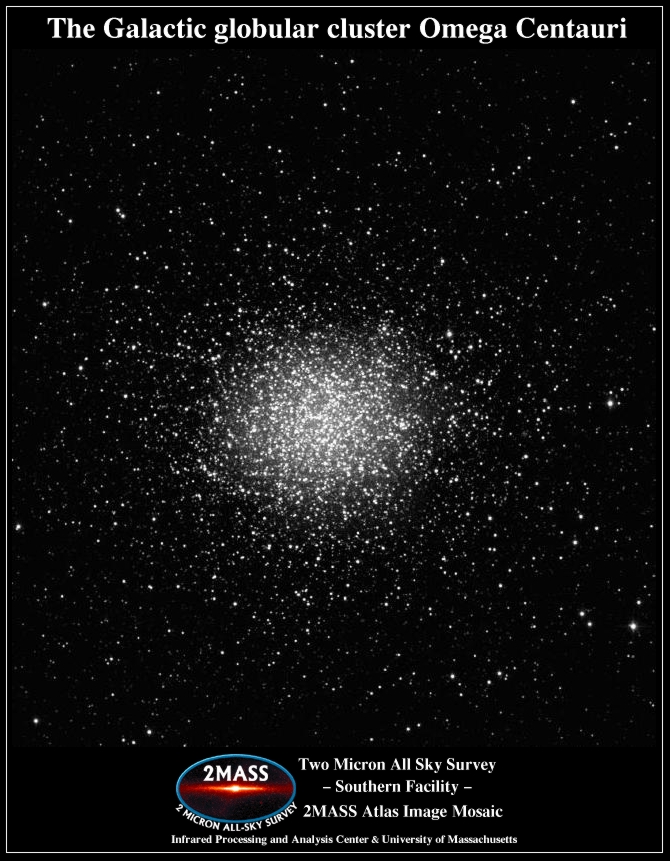
|
This 2MASS image shows the globular cluster Omega Centauri.
Image credit: E. Kopan (IPAC) |
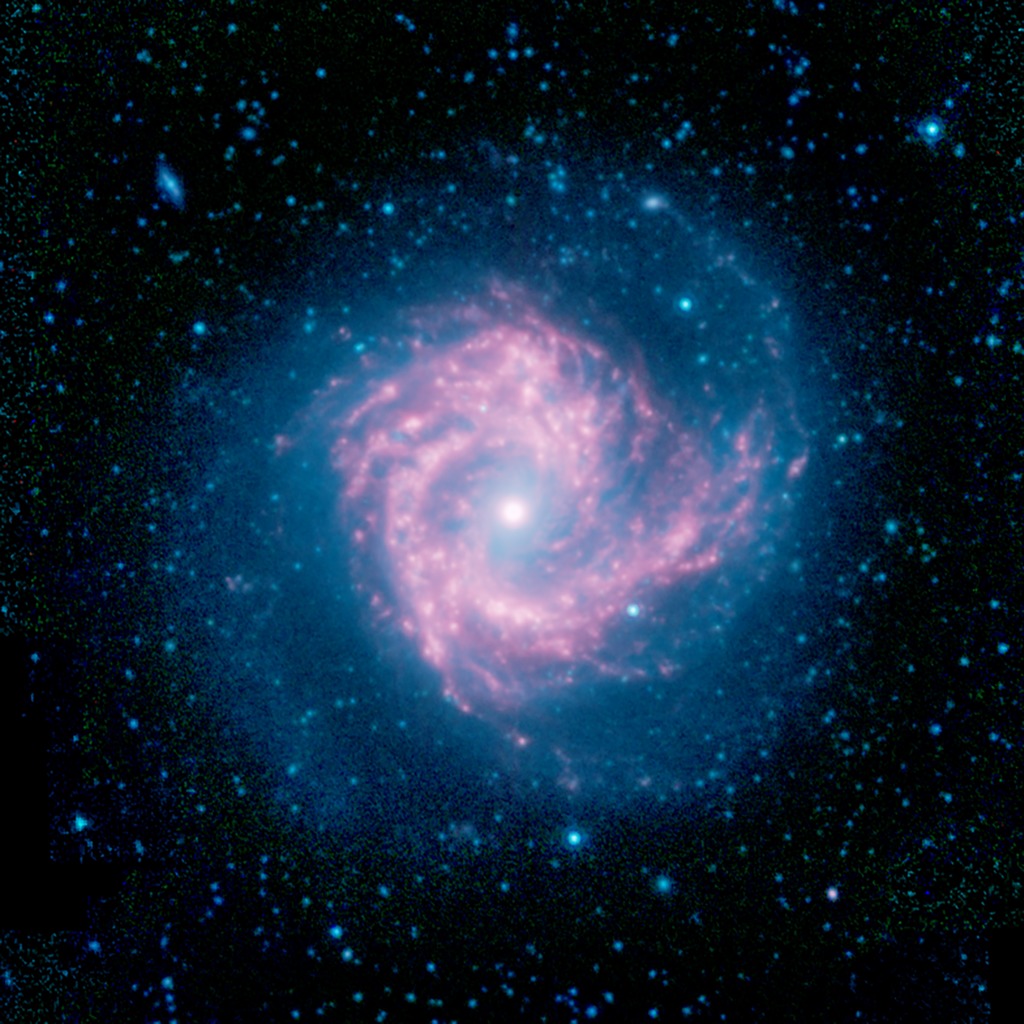
|
This Spitzer image shows the starburst galaxy M61.
Image credit: NASA/JPL-Caltech |

|
This WISE image shows the Barnard 3 nebula. The bright star in the center of the red dust cloud is HD 278942.
Image credit: NASA/JPL-Caltech/WISE Team |
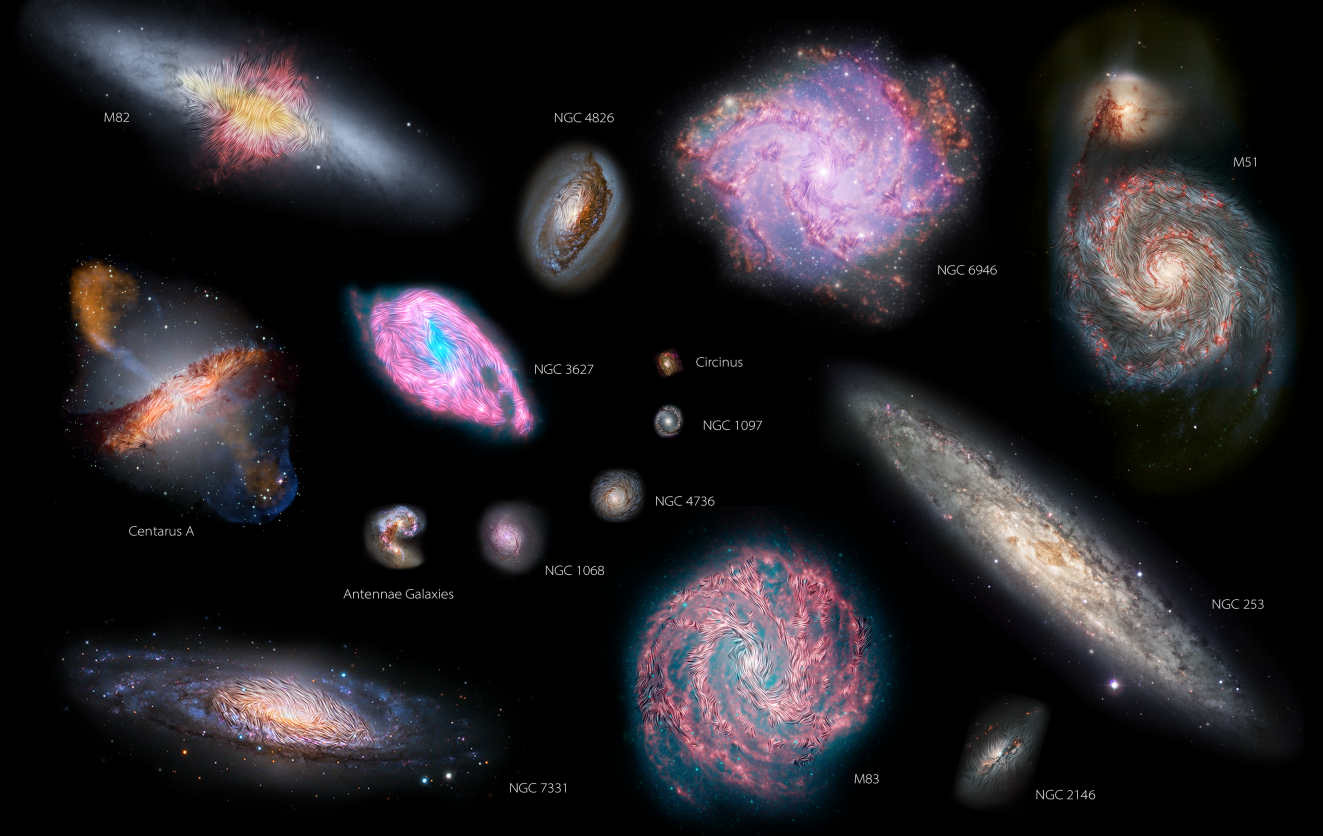
|
The Survey of extragALactic magnetiSm with SOFIA (SALSA) program used HAWC+ to analyze the magnetic fields of 14 nearby galaxies.
Image credit: Borlaff et al. (2023) |
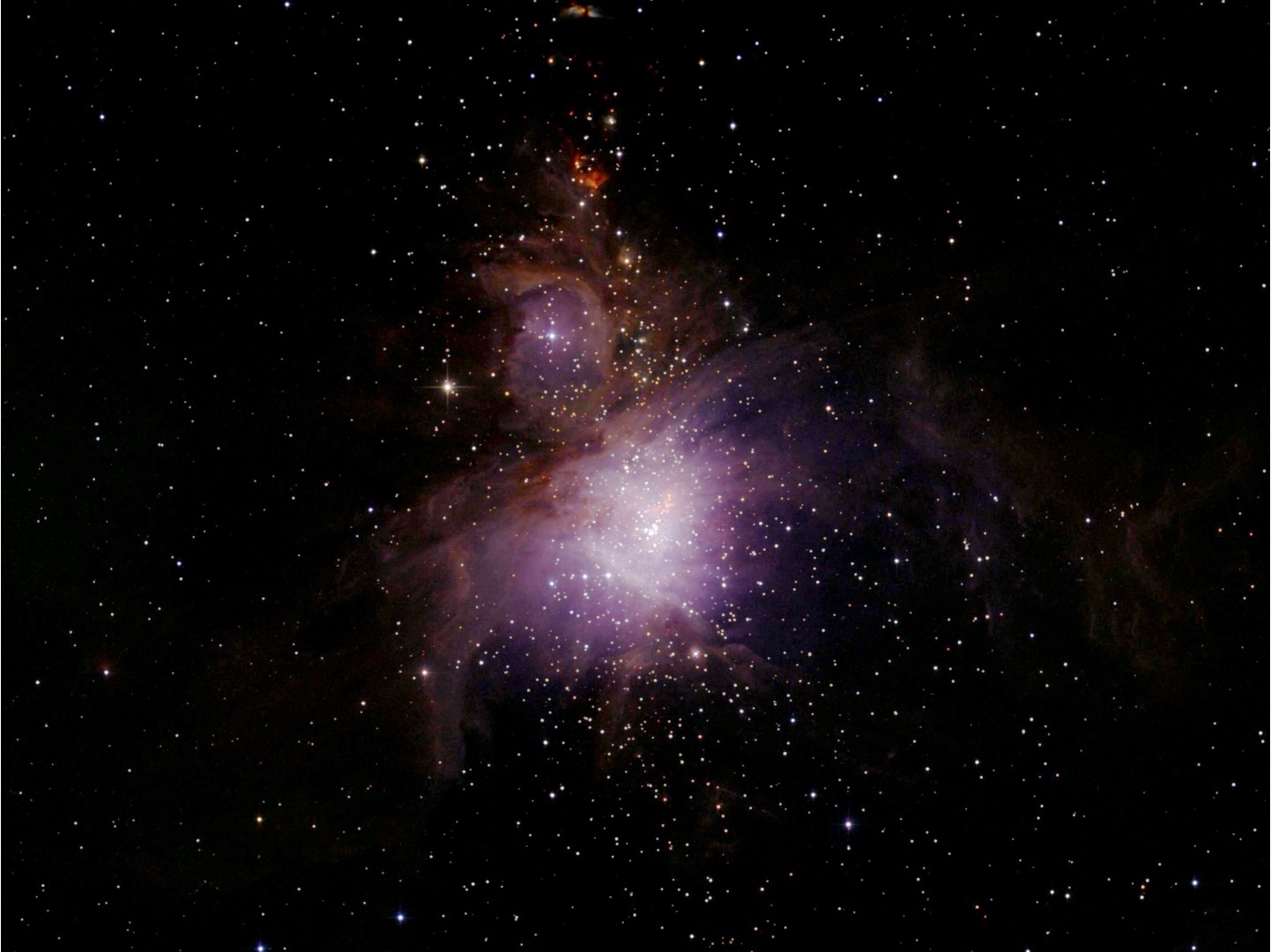
|
This 2MASS image shows the Orion Nebula. Over 3000 young stars in the Trapezium cluster illuminate a gaseous bubble on the near side of the Orion-A Molecular Cloud. To the north of the Orion Nebula is the OMC-2 molecular cloud and a series of red stars signifying young, embedded protostellar objects.
Image credit: E. Kopan (IPAC) |

|
This Spitzer and Hubble image of the interacting galaxy pair Arp 148 shows a supernova that is hidden by dust and only visible in the infrared.
Image credit: NASA/JPL-Caltech/STScI |
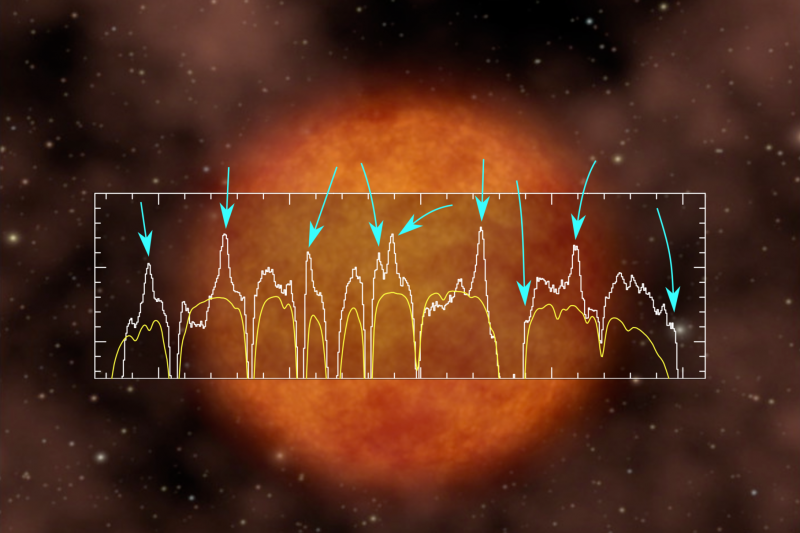
|
A portion of the SOFIA EXES spectrum of R Leonis (white) superimposed on an artistic interpretation of the star. The arrows indicate several CO2 emission line peaks near 13.5 microns, and the yellow line is a model of Earth’s atmospheric transmission.
Image credit: Fonfria et al. (2020) |
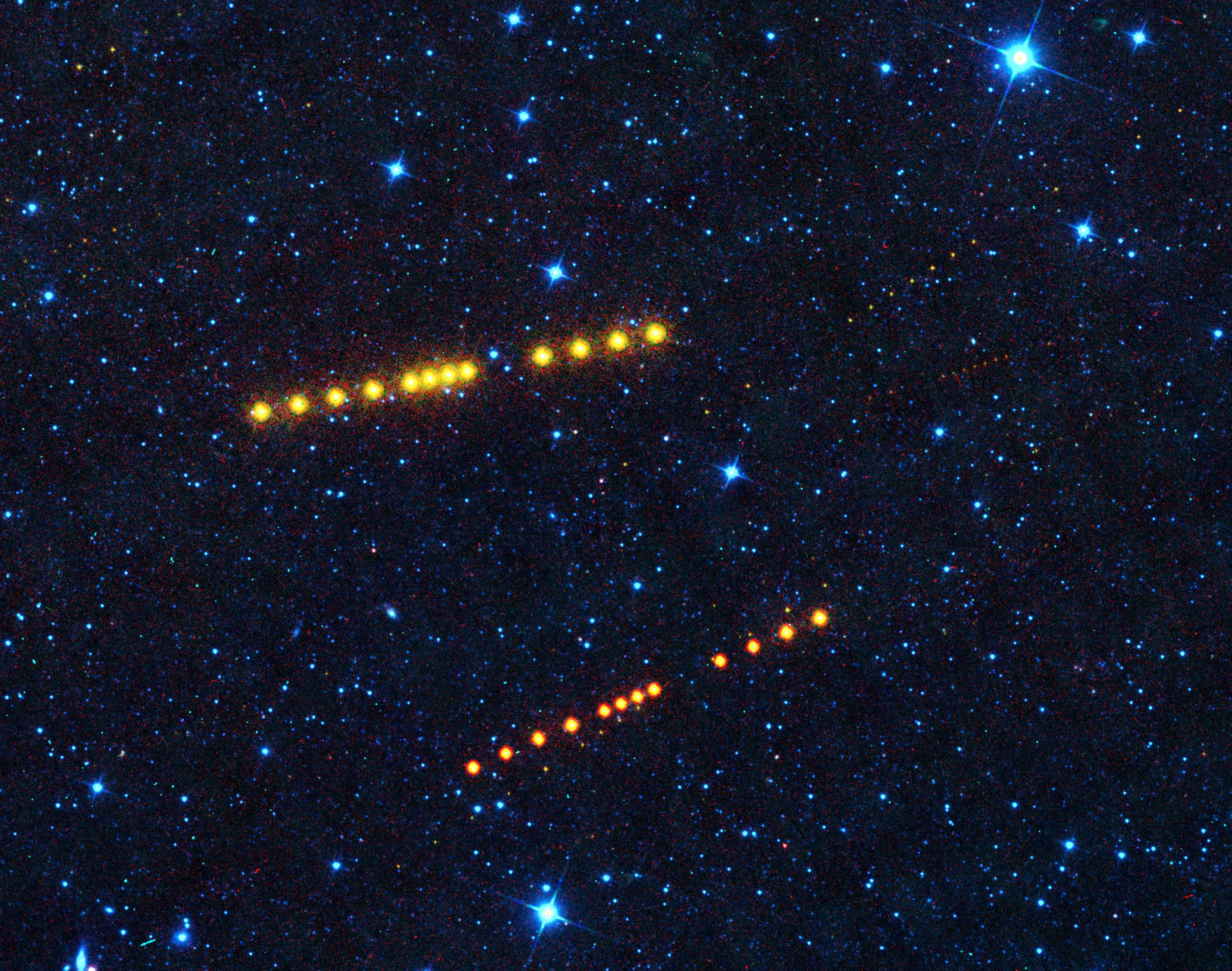
|
This NEOWISE image shows the asteroids Klotho and Lina, as well as several smaller asteroids.
Image credit: NASA/JPL-Caltech/UCLA |

|
This 2MASS image shows the nearby starburst galaxy NGC 253
Image credit: S. Van Dyk (IPAC) |
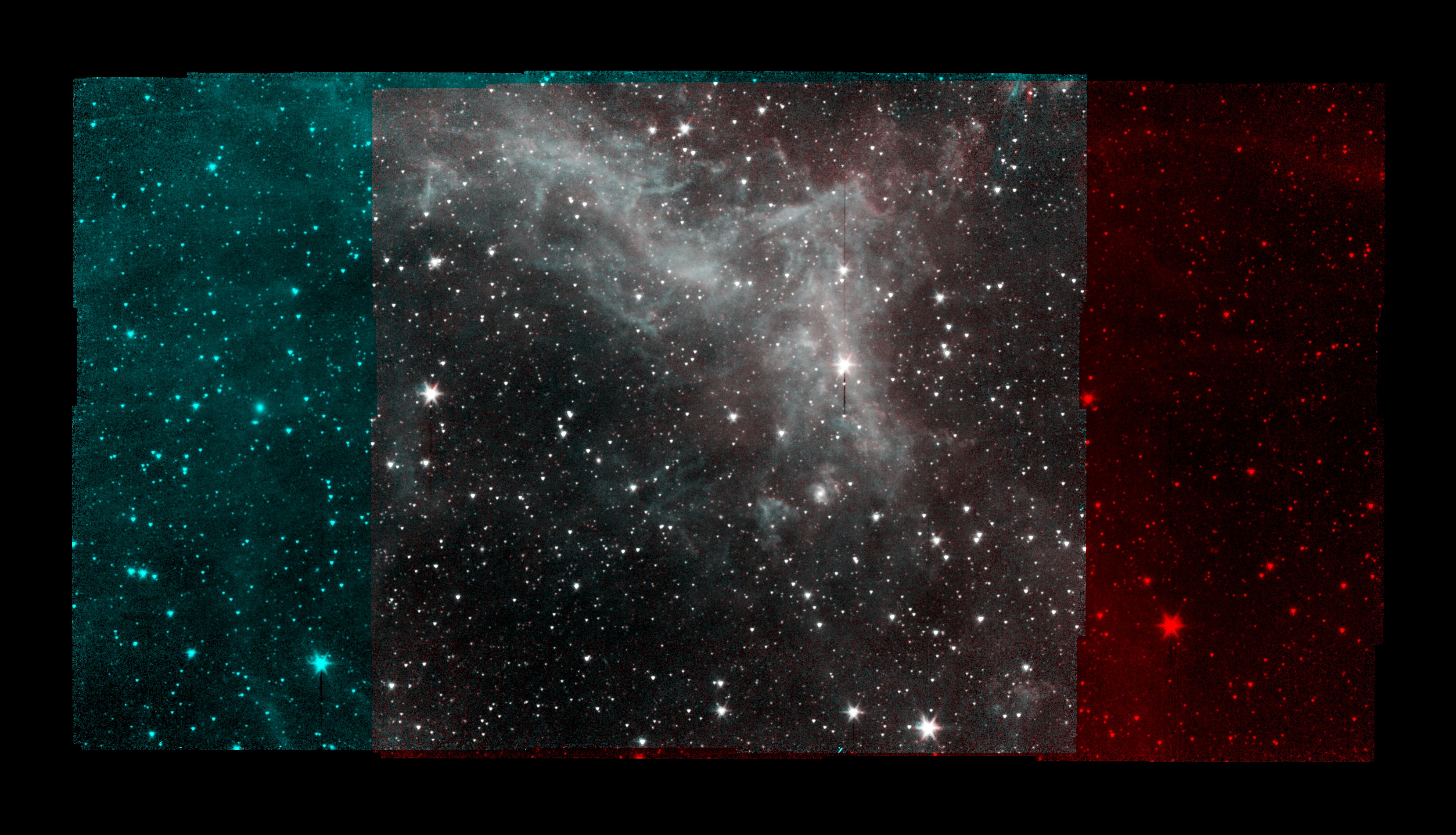
|
This Spitzer image taken on January 25, 2020 shows part of the California Nebula. This was the final mosaic taken before the end of the Spitzer mission.
Image credit: NASA/JPL-Caltech |
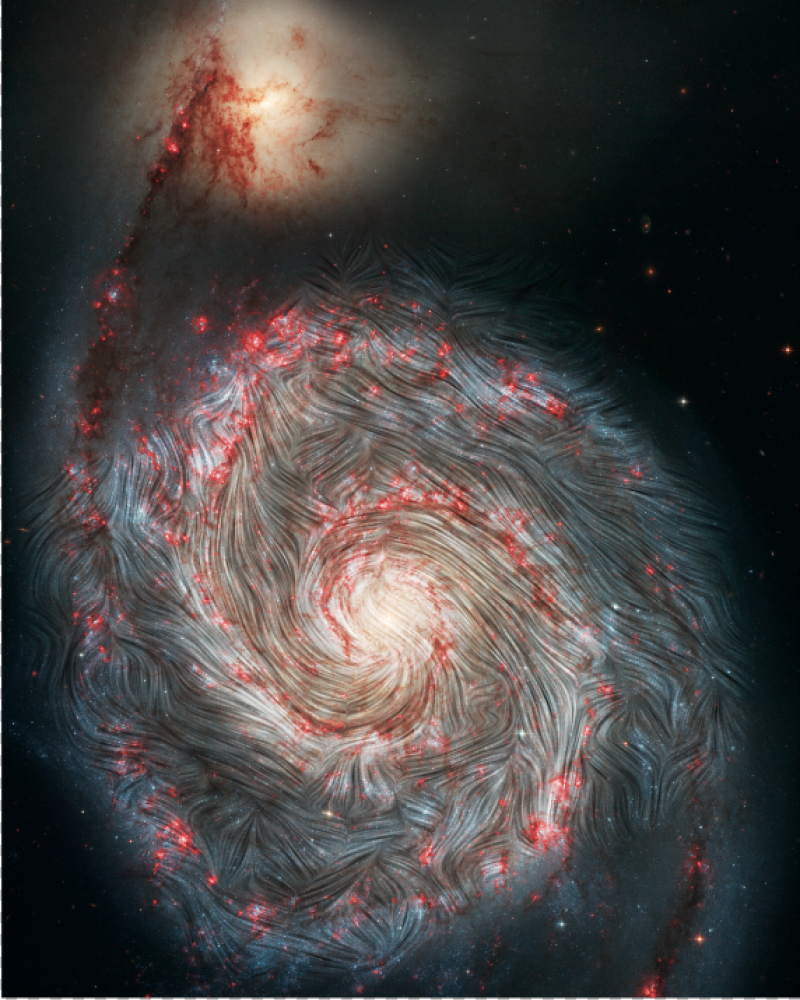
|
Magnetic field streamlines detected by the HAWC+ instrument on SOFIA are shown over an image of the Whirlpool galaxy from NASA's Hubble Space Telescope.
Image credit: NASA/SOFIA/STScI/AURA |

|
This ground-based image shows comet C/2020 F3 NEOWISE, with the International Space Station passing through the top of the image
Image credit: NASA/Bill Ingalls |
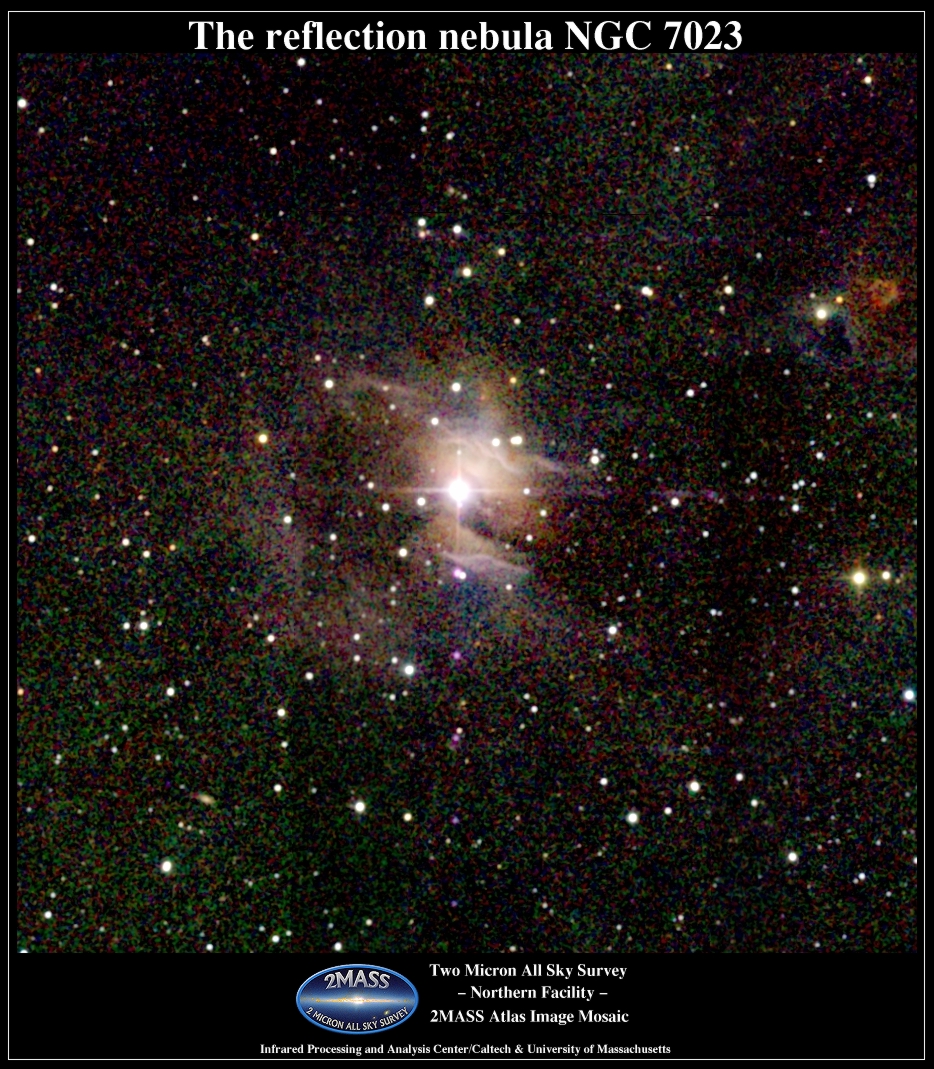
|
This 2MASS image shows the reflection nebula NGC 7023, also known as the Iris Nebula.
Image credit: IPAC-Caltech & UMass |
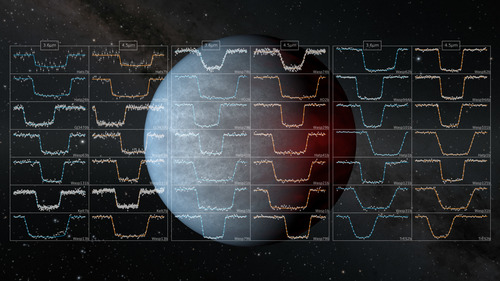
|
Artist's rendering of a hot Jupiter, with samples of light curve data from hot Jupiters observed by Spitzer.
Image credit: NASA/JPL-Caltech |
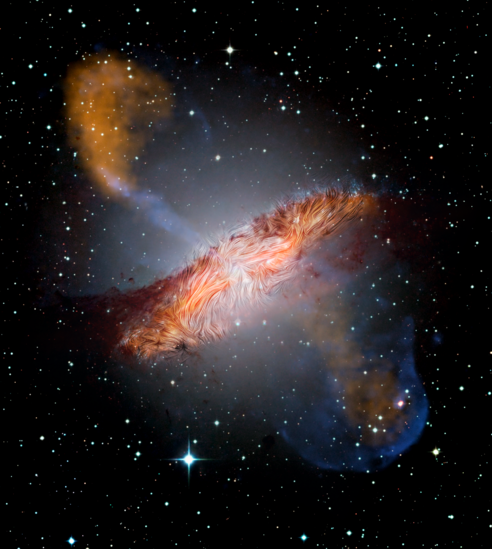
|
Magnetic field measurements from SOFIA HAWC+ are shown over a multiwavelength composite of Centaurus A from ESO, APEX, Chandra, and Spitzer.
Image credit: ESO WFI/MPIRA-ESO-APEX/NASA-Chandra/JPL-Caltech/SOFIA |
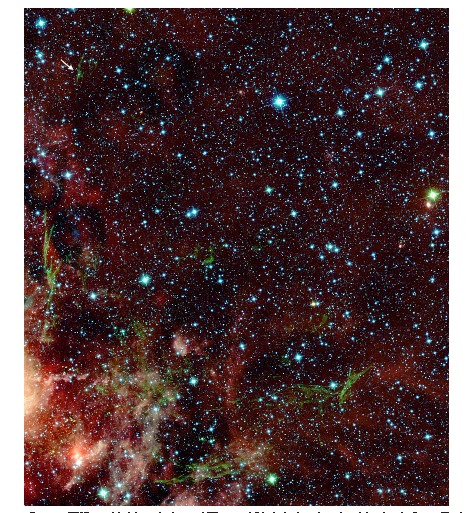
|
This WISE image shows the HB 3 (G132.7+1.3) supernova remnant. The 4.6 micron (green) image is dominated by molecular hydrogen and highlights interacting regions between the SNR and molecular clouds.
Image credit: Rho et al. (2021) |
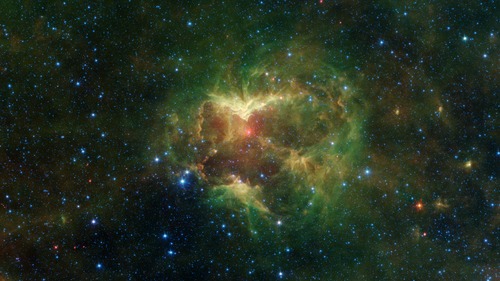
|
This Spitzer image shows a cloud of gas and dust carved out by a star 15-20 times the Sun's mass. The structure has been nicknamed the Jack-o'-lantern Nebula. |
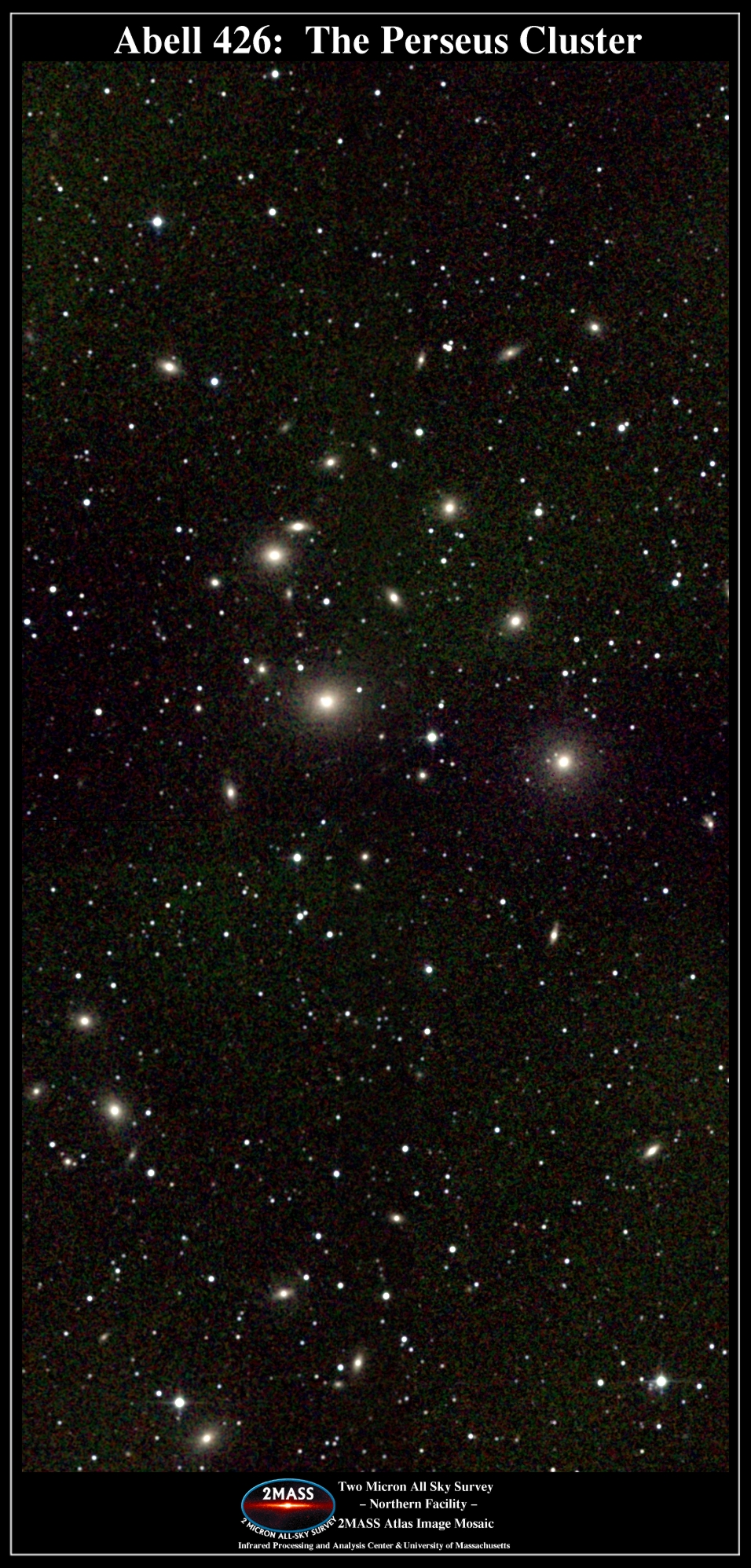
|
This 2MASS image shows the Perseus Cluster, a nearby rich galaxy cluster. |
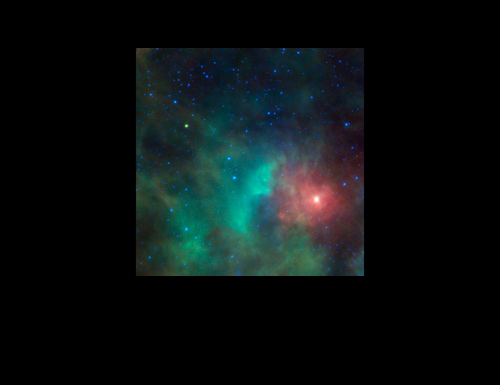
|
This NEOWISE image shows the Near-Earth Object 1998 KN3 (upper left), gas and dust near the Orion Nebula in the background.
Image credit: NASA/JPL-Caltech |
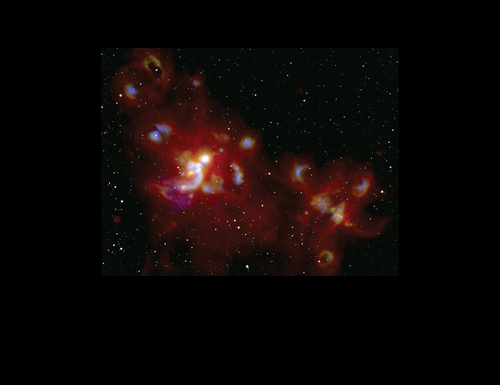
|
This SOFIA image shows mid-infrared emission from massive stars in the star forming region W51. FORCAST data is shown in color over a background SDSS image.
Image credit: NASA/SOFIA/Lim and De Buizer et al. and Sloan Digital Sky Survey |
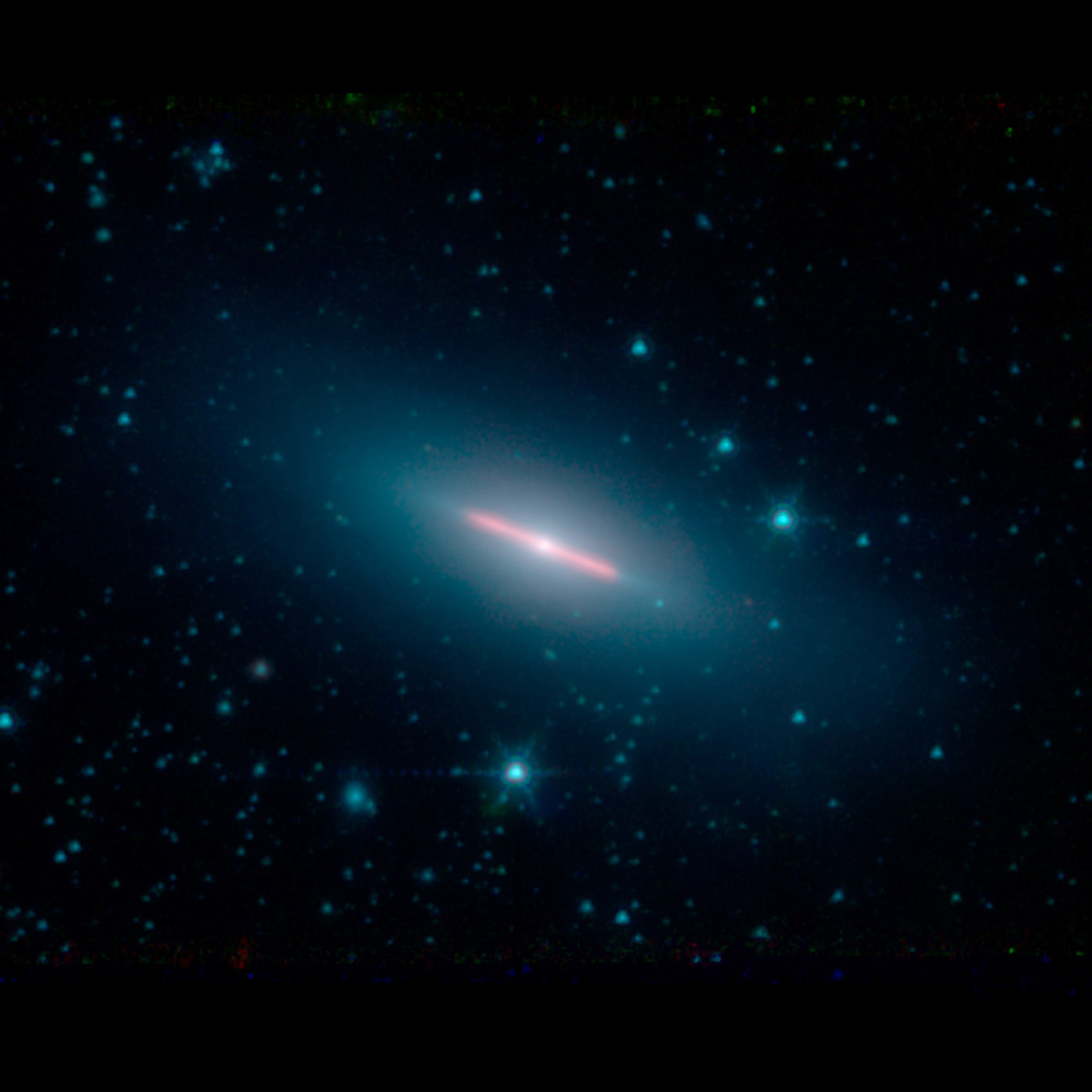
|
This Spitzer image shows the edge-on spiral galaxy NGC 5866.
Image credit: NASA/JPL-Caltech |
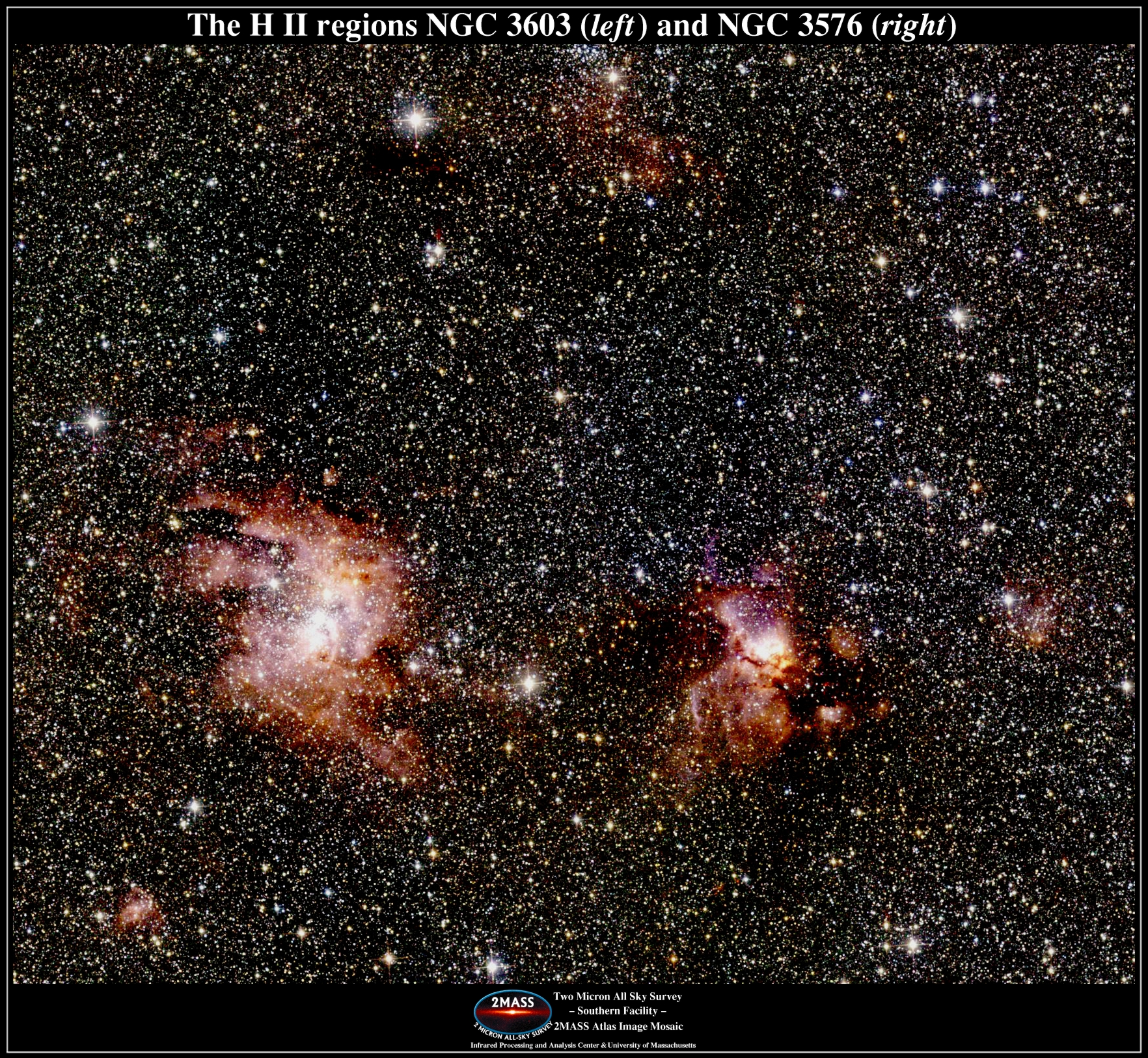
|
This 2MASS image shows NGC 3603 (left) and NGC 3576 (right), among the largest HII regions in the Galaxy. NGC 3603 is about twice as far away as NGC 3576.
Image credit: E. Kopan (IPAC) |

|
Right panel: Image of Comet 2020 F3 NEOWISE, with the NEOWISE spacecraft passing through the foreground (diagonal streak). Left panel: the field NEOWISE imaged at that time.
Image credit: A. Schiano (right); NASA/JPL-Caltech (left) |
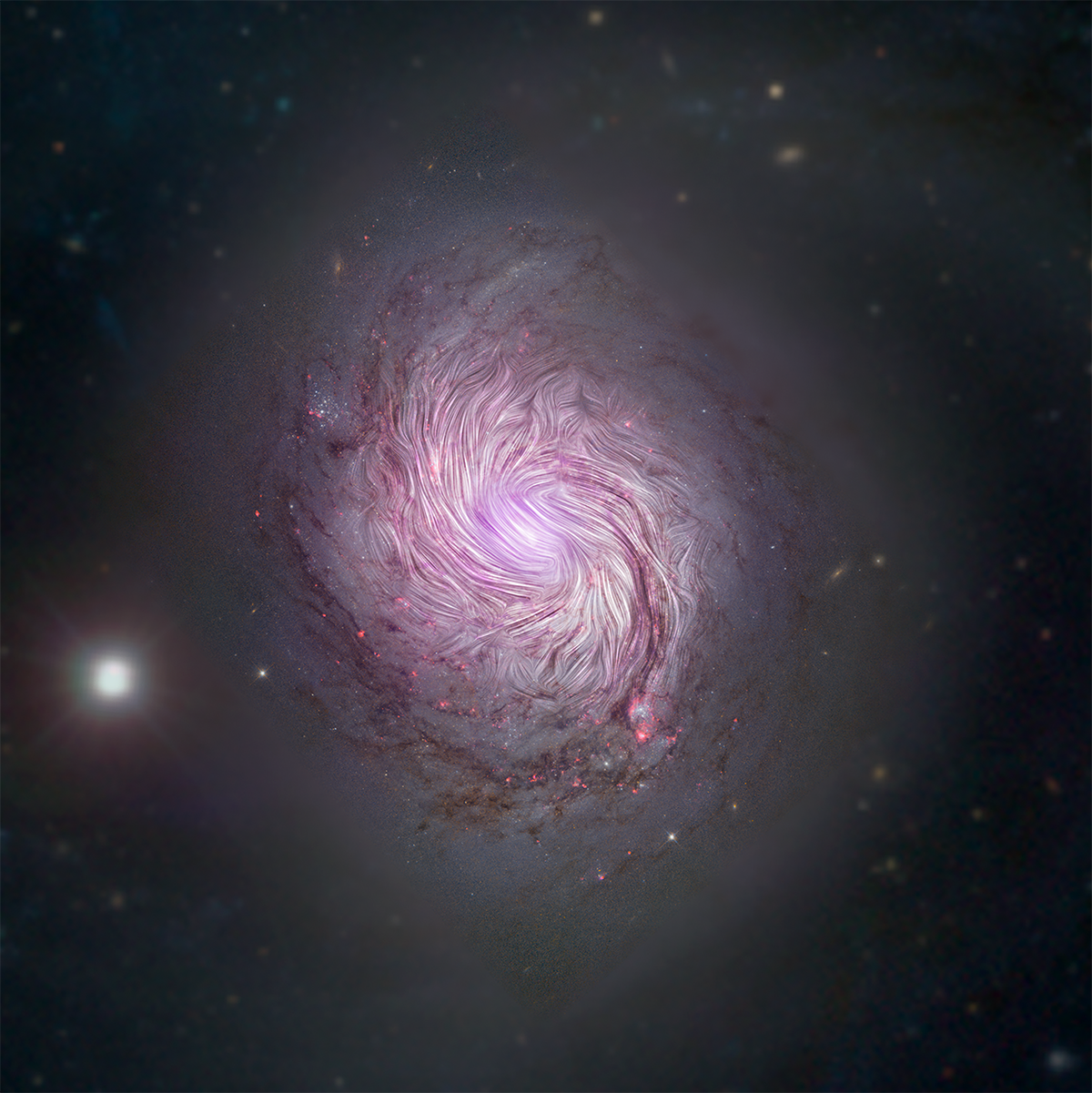
|
Far-infrared polarimetry with SOFIA's HAWC+ instrument measured the magnetic field throughout the nearby Seyfert galaxy NGC 1068. The magnetic field streamlines are shown over a visible light and x-ray composite image using Hubble, SDSS, and NuSTAR data.
Image credit: NASA/SOFIA; NASA/JPL-Caltech/Roma Tre Univ. |
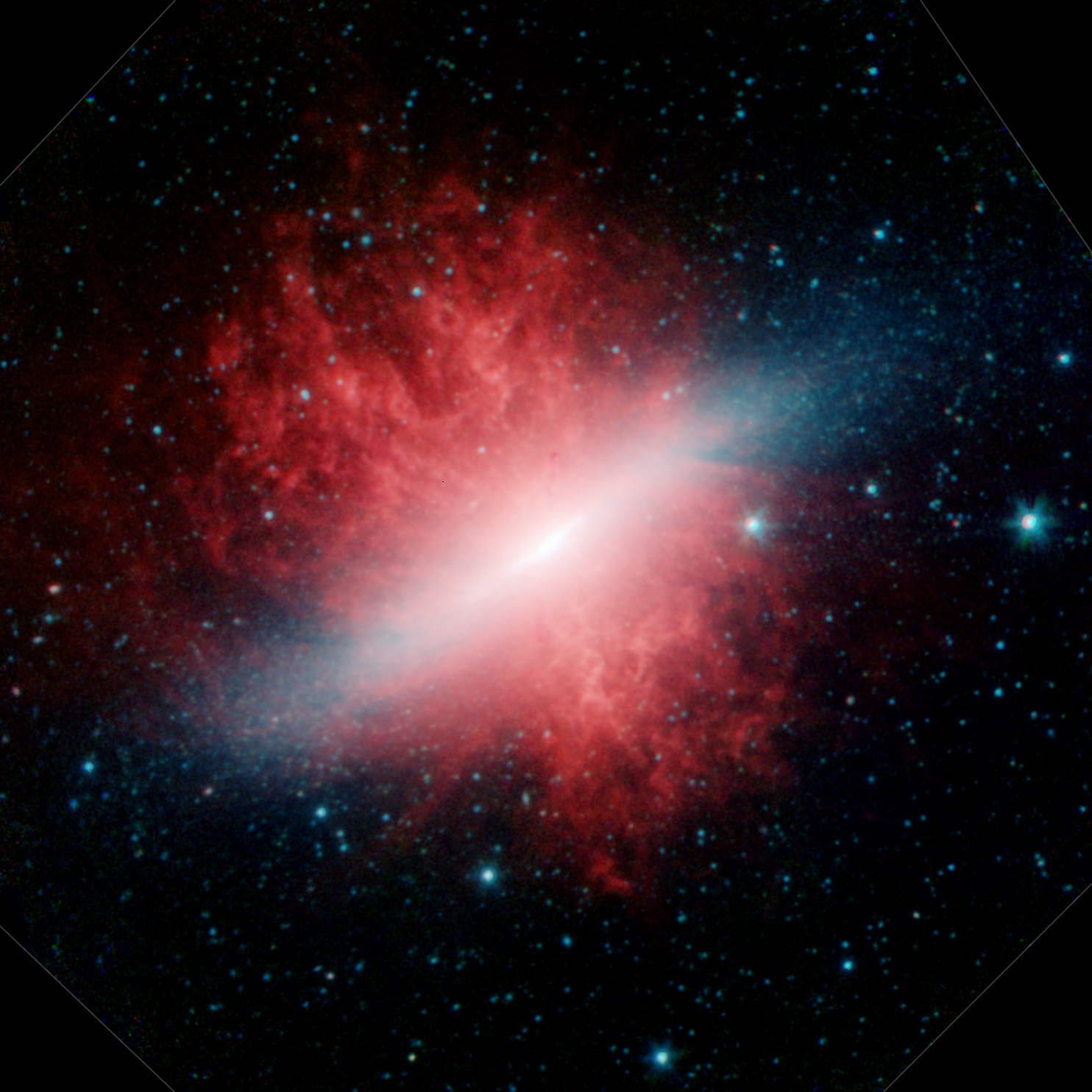
|
This Spitzer image from the SINGS Legacy program shows the galaxy M82, with dust (red) being blown out by the starburst in the core of the galaxy.
Image credit: NASA/JPL-Caltech/C. Engelbracht (University of Arizona) |
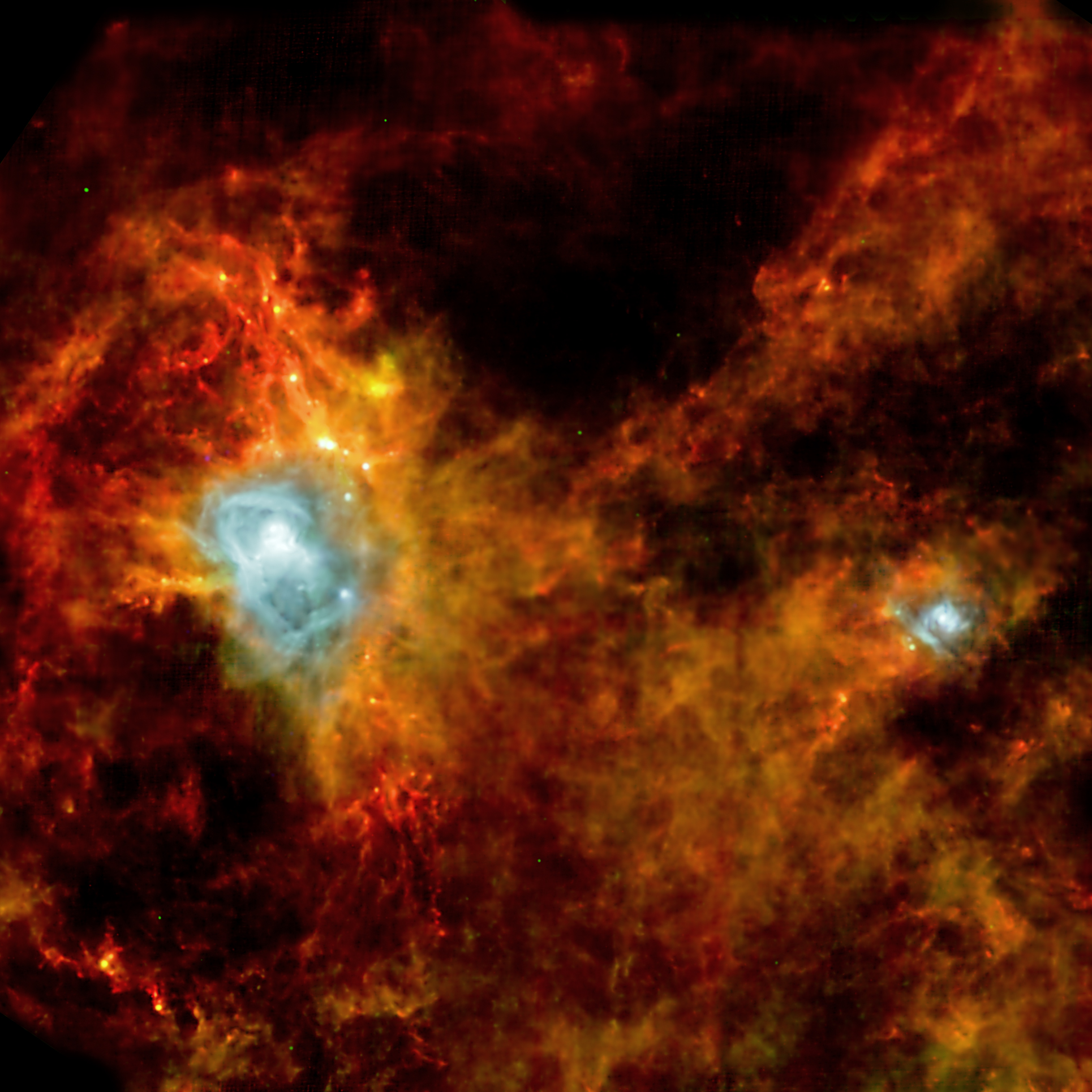
|
This Herschel image of the Aquila Rift shows the extended filamentary structure of this star- forming cloud. Over 500 compact cores have been detected embedded in the filaments in this region. The two glowing cavities on opposite sides of the image are HII regions.
Image credit: ESA/Herschel/SPIRE/PACS/Ph. Andre (CEA Saclay) |
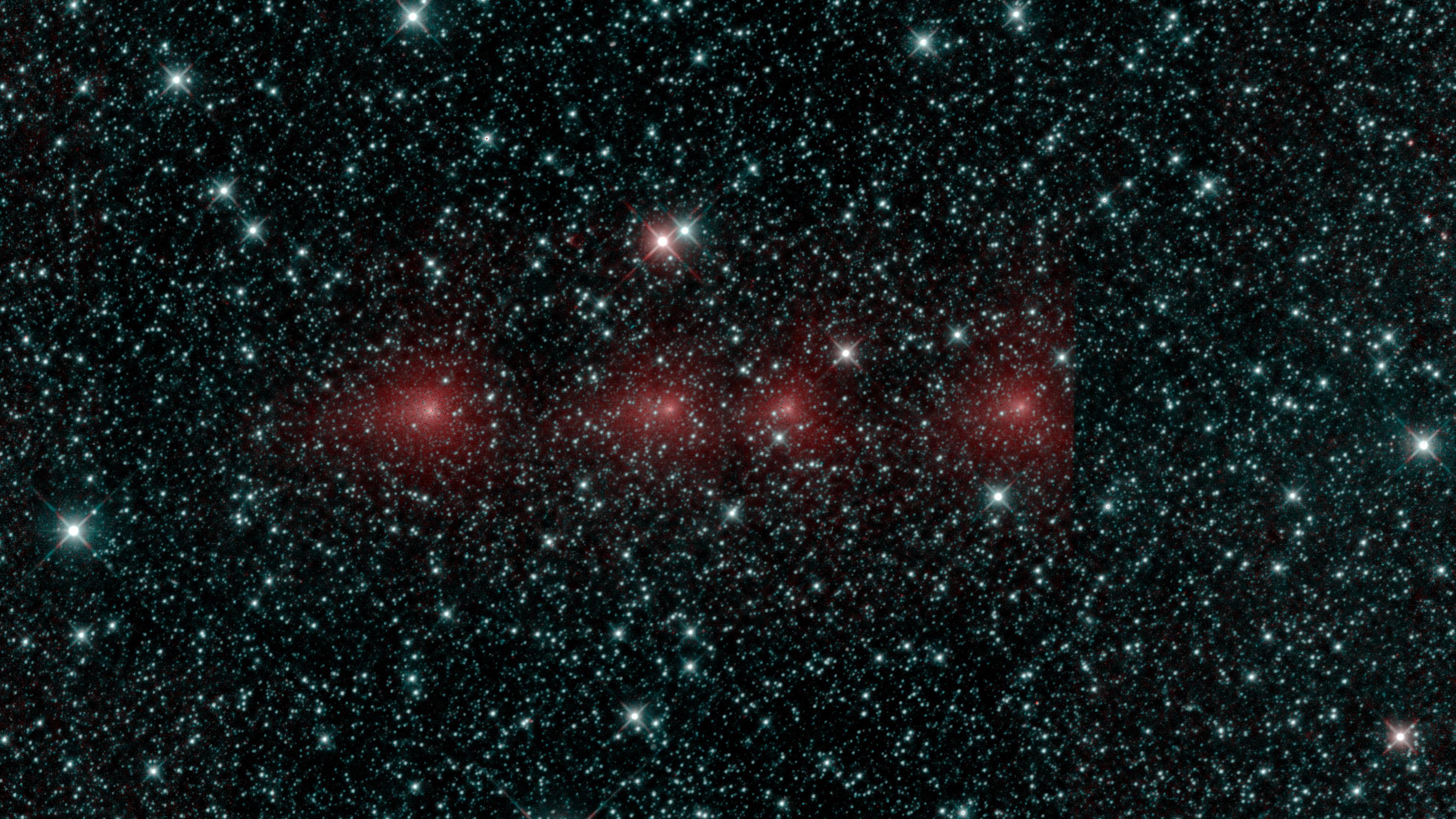
|
This NEOWISE image shows the comet C/2018 Y1 Iwamoto in a series of exposures taken on Feb. 25, 2019.
Image credit: NASA/JPL-Caltech |
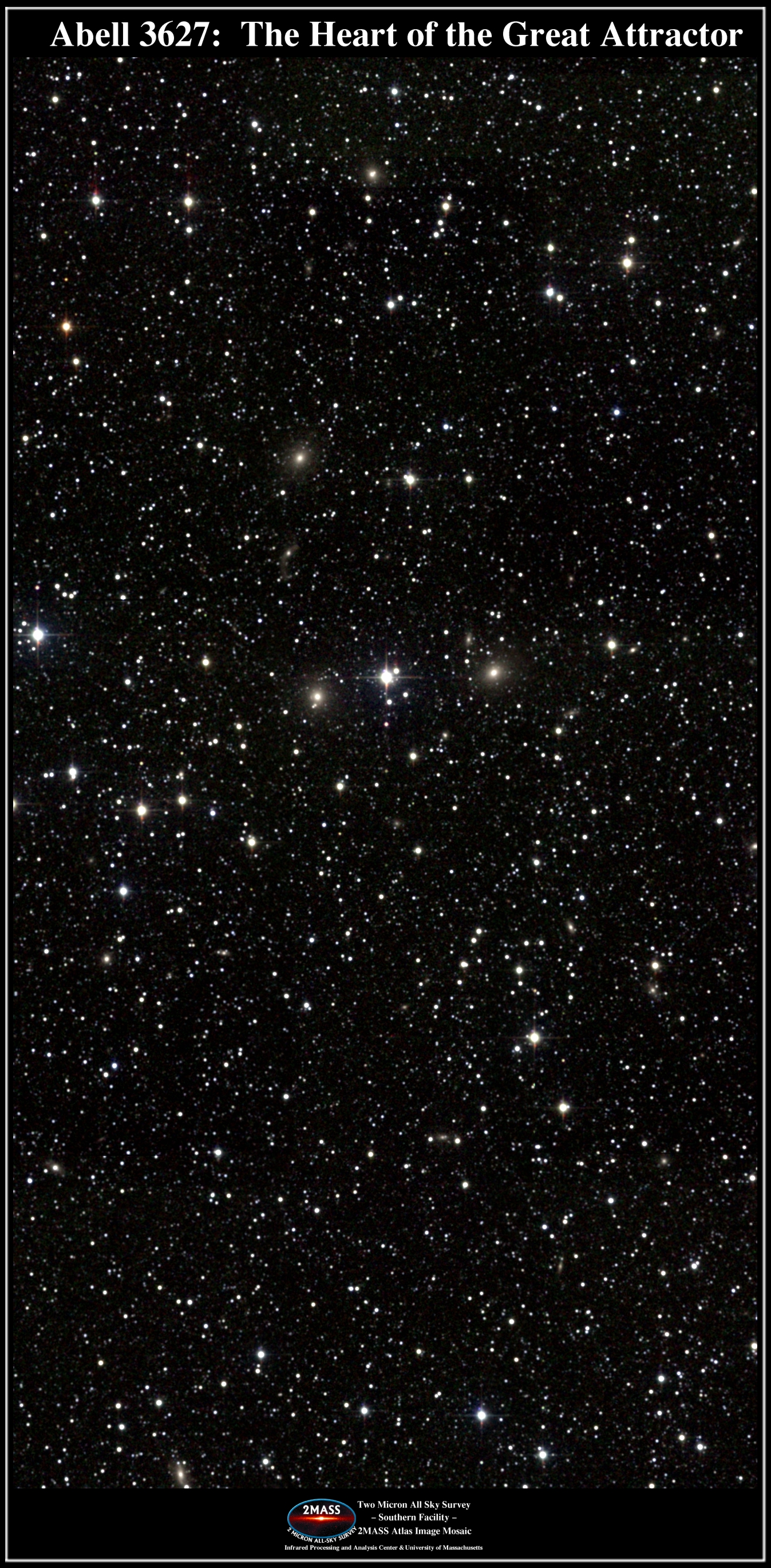
|
2MASS image of the galaxy cluster Abell 3627, a very rich galaxy cluster. It lies near the center of the Great Attractor, the center of a large mass concentration of galaxies and galaxy clusters known as the Local Supercluster.
Image credit: S. Van Dyk (IPAC) |

|
This Spitzer image shows the galaxy NGC 1291, with a bright star-forming ring (red, 8 microns) in the outer disk.
Image credit: NASA/JPL-Caltech |
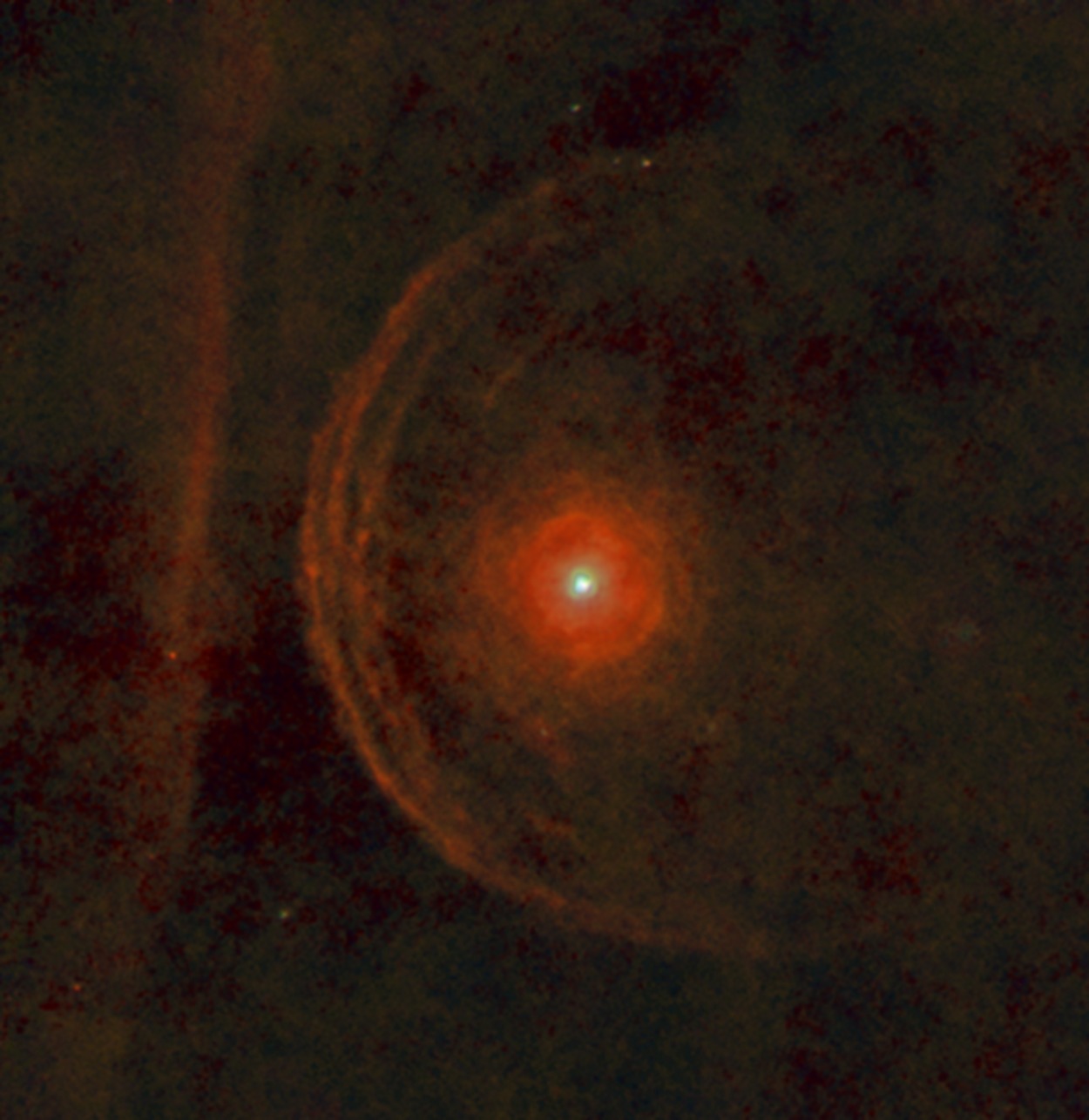
|
Betelgeuse as seen by Herschel's PACS instrument (70-160 microns). The arc to the left is from material ejected from the star, shaped by its bow shock as it moves through the interstellar medium at around 30 km/s. The linear bar of dust to the left is a separate feature which the bow shock will reach in 5,000 years and Betelgeuse will reach in 12,500 years.
Image credit: ESA/Herschel/PACS/L. Decin et al. |

|
ESA's Gaia mission measured the position and brightness of 1.7 billion stars, with distances, proper motions, and colors for more than 1.3 billion stars.
Image credit: ESA/Gaia/DPAC |

|
This WISE image shows the Circinus galaxy. At a distance of 14 million light years, it is one of the nearest galaxies, but difficult to observe since it lies behind the disk of the Milky Way. Circinus has an active galactic nucleus, as well as two extended spiral arms.
Image credit: NASA/JPL-Caltech/WISE Team |

|
This 2MASS image shows NGC 3199, a partial ring blown by the wind from the Wolf-Rayet star WR 18 (leftmost of the three bright stars near center). Wolf-Rayet stars represent the final evolutionary stage of very massive stars (~30 solar masses or more).
Image credit: S. Van Dyk (IPAC) |
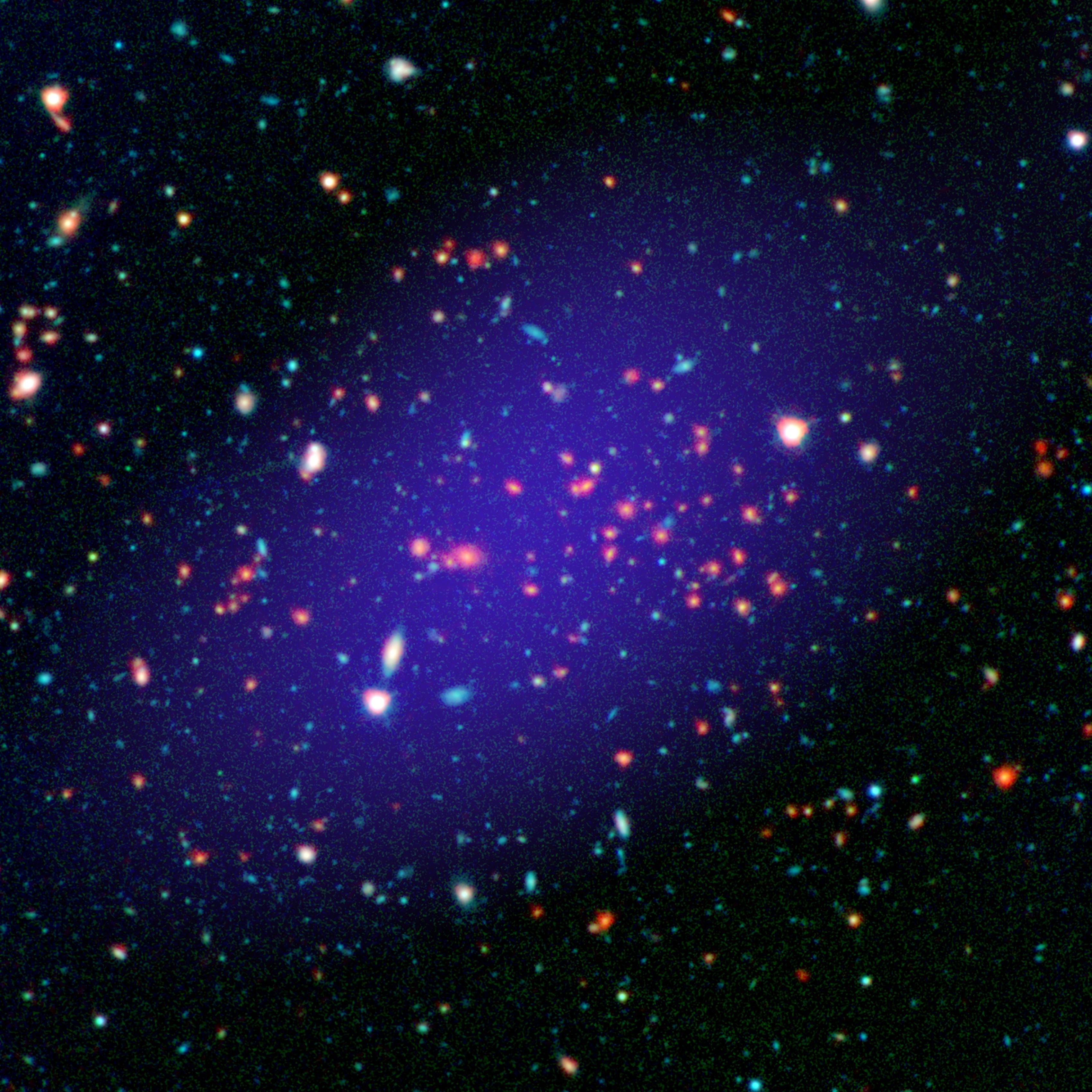
|
The galaxy cluster called MOO J1142+1527 can be seen here in Spitzer 3.6 micron (red), Gemini optical and near-IR (blue, green), and CARMA radio observations (purple).
Image credit: NASA/JPL-Caltech/Gemini/CARMA |
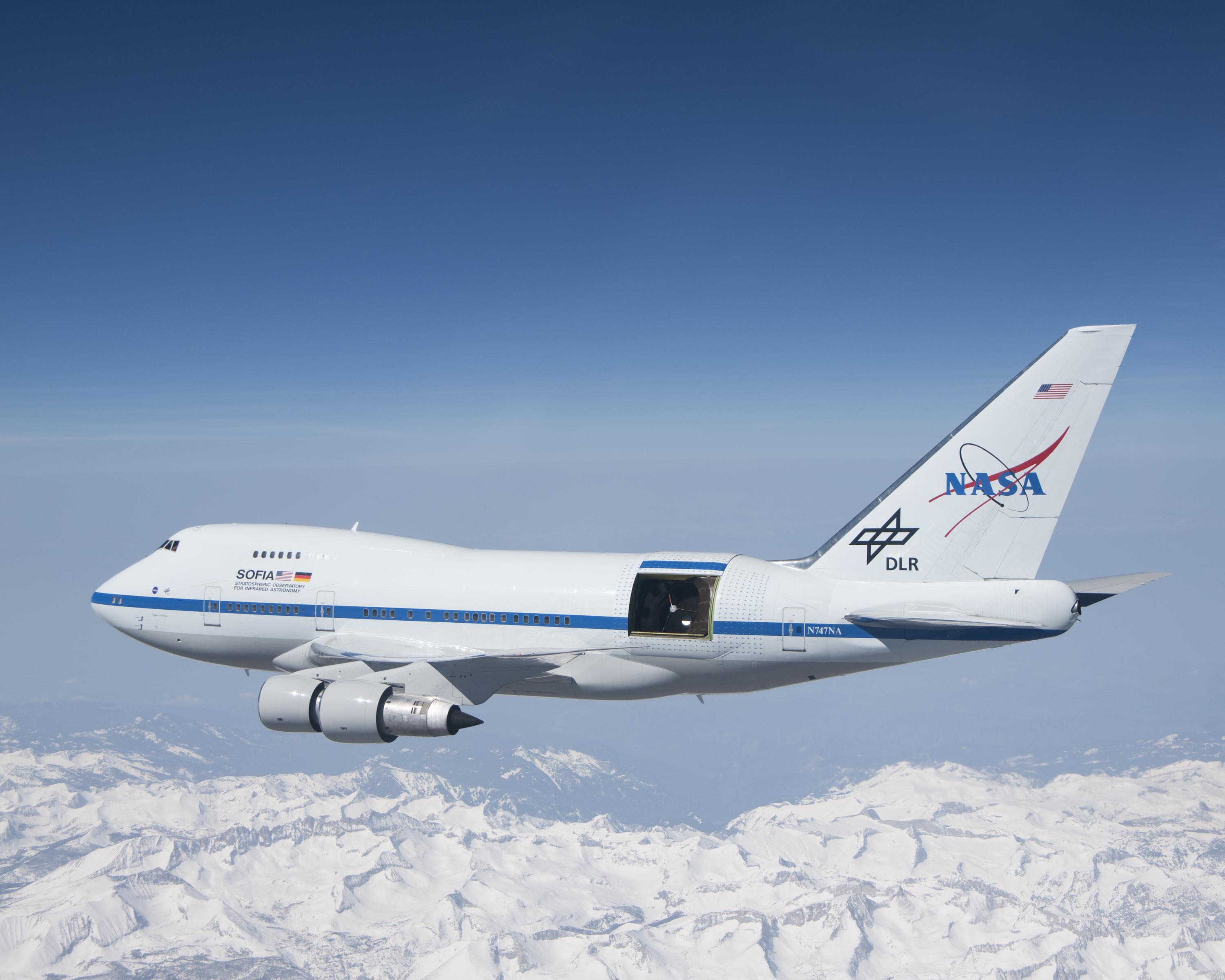
|
IRSA will host the SOFIA Science Data Archive starting in February 2019. The first release will consist of FIFI-LS, FORCAST, and GREAT data from Cycles 4 & 5.
Image credit: NASA/Jim Ross |
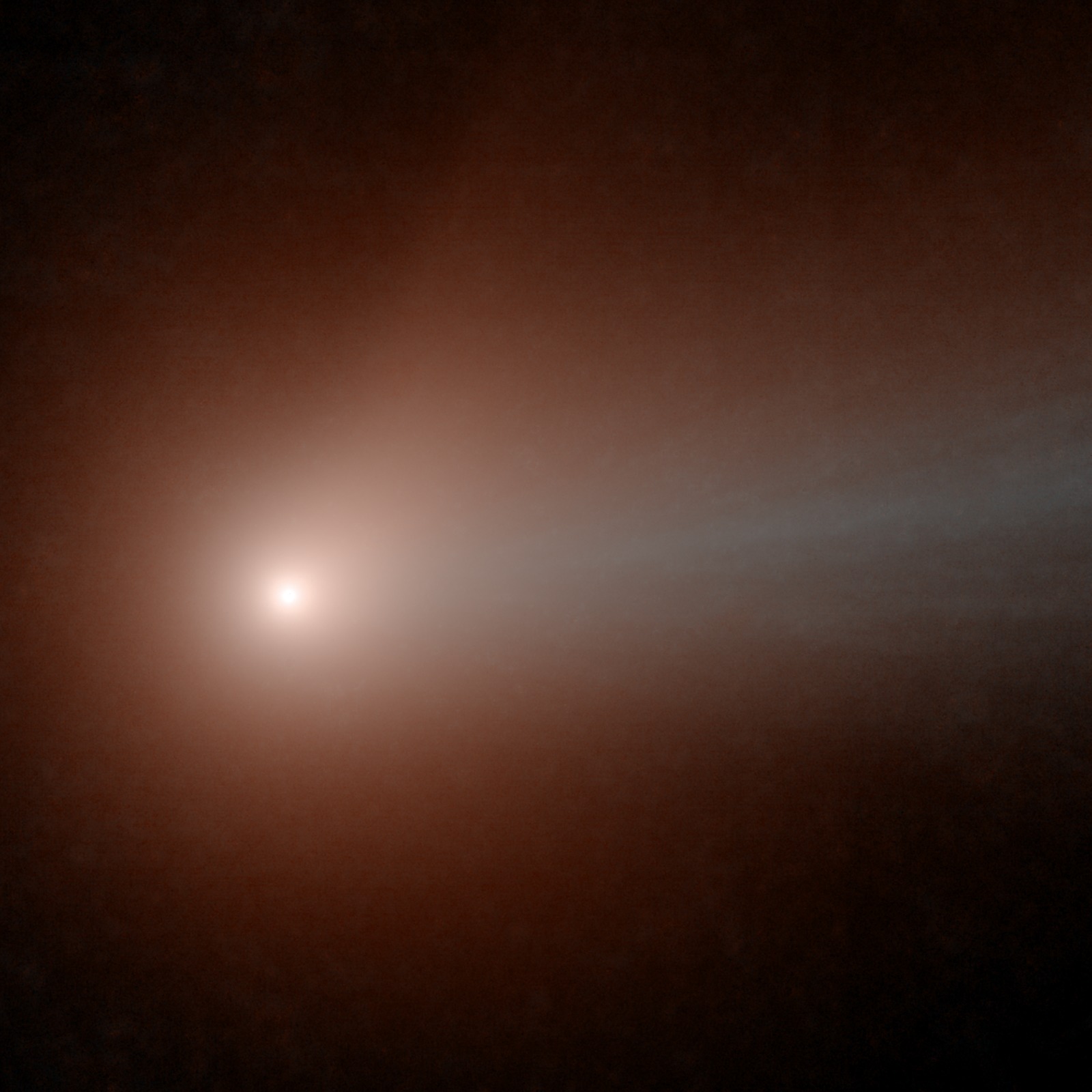
|
Comet C/2014 Q2 (Lovejoy) as seen by NEOWISE during the comet's perihelion passage in January 2015.
Image credit: NASA/JPL-Caltech |
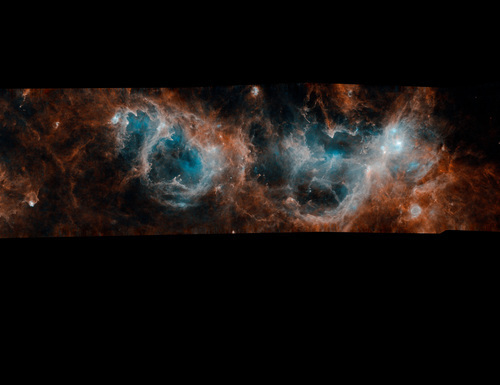
|
This image shows the W3/W4/W5 molecular cloud complex as seen by Herschel's PACS instrument (cyan, 70 microns; orange, 100 microns).
Image credit: ESA/Herschel/NASA/JPL-Caltech; acknowledgement: R. Hurt (JPL-Caltech) |
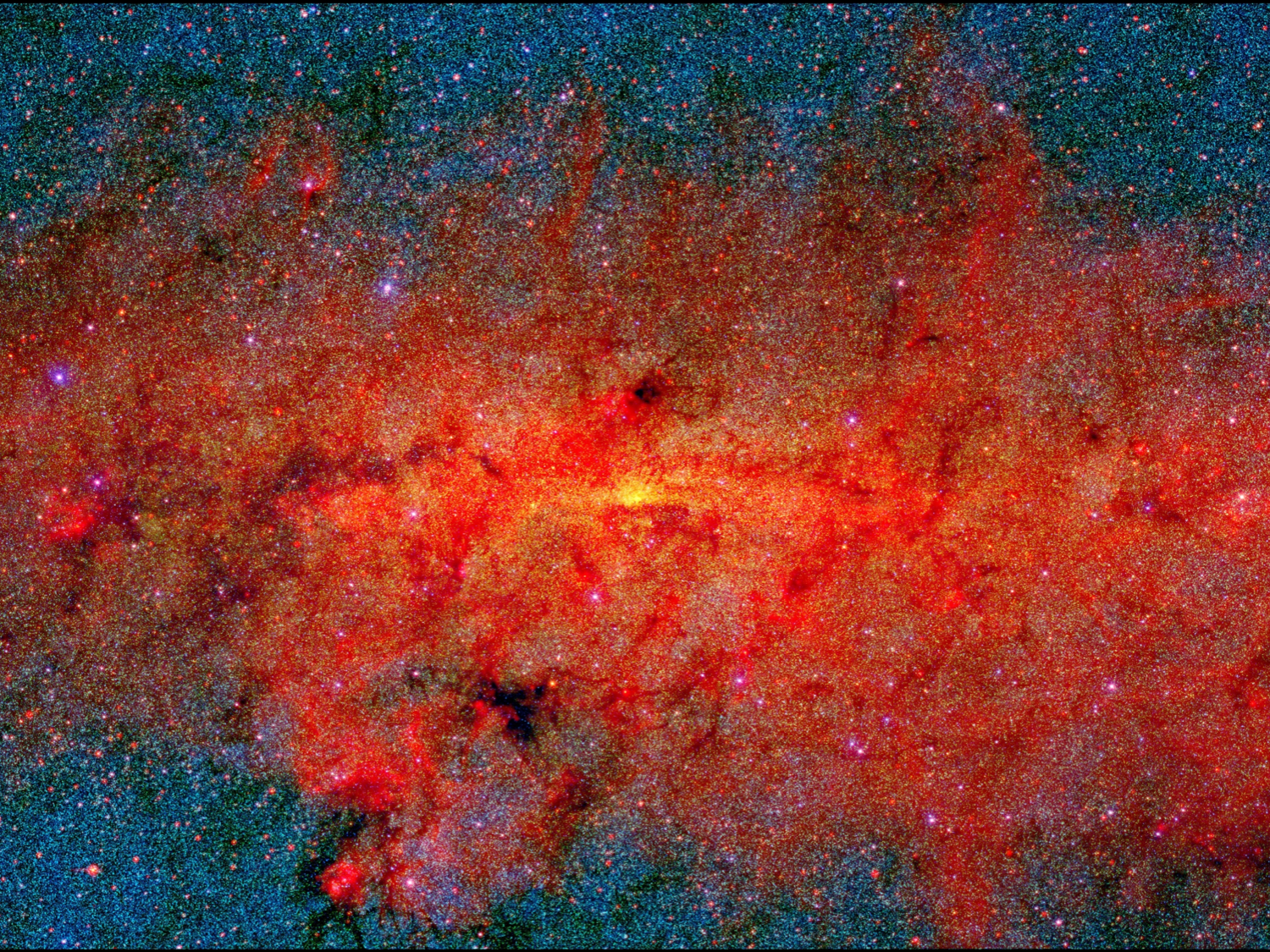
|
This image is a composite of 2MASS J (blue), Ks (green), and MSX Band A (6 - 11 micron, red) imaging of the Galactic Center.
Image credit: E. Kopan (IPAC) |
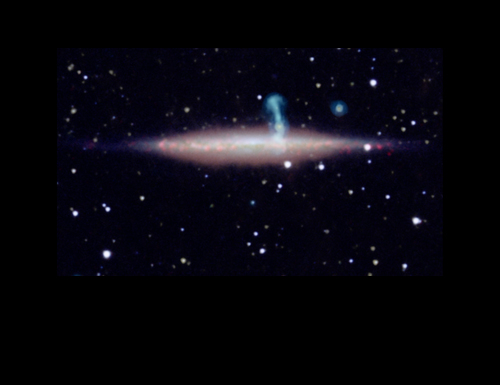
|
New detailed radio observations of UGC 10288 from the VLA revealed that the large perpendicular extension of UGC 10288's halo (blue) is really a distant background galaxy with radio jets. Infrared observations from the Spitzer Space Telescope and Wide-field Infrared Survey Explorer (WISE) are yellow and orange, respectively.
Image credit: VLA/NASA/JPL-Caltech/SDSS/NOAO/University of Manitoba |
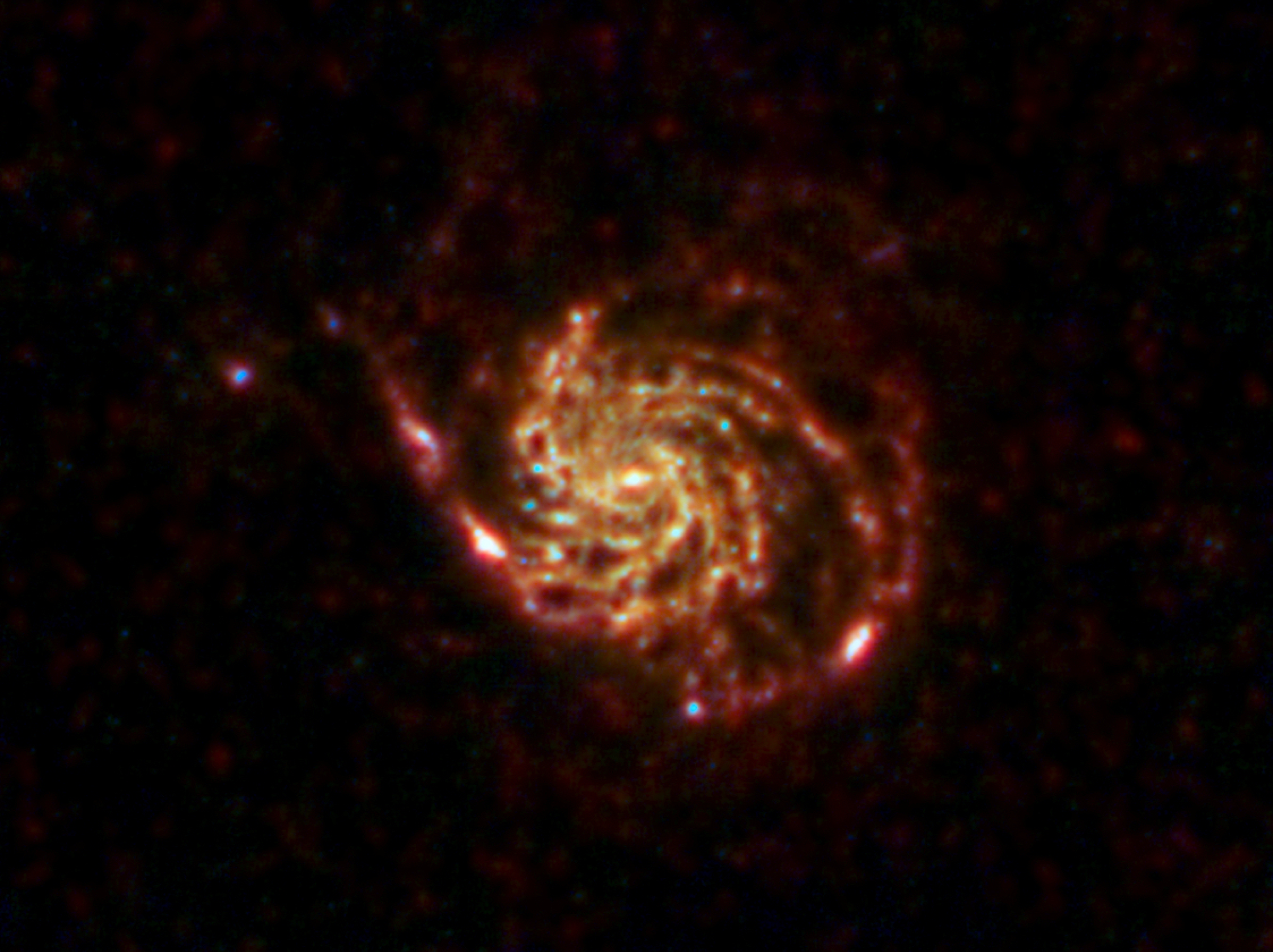
|
This image shows the Pinwheel Galaxy, also known as M101, as viewed by ESA's Herschel Space Observatory. Lying more than 20 million light-years from us, this spiral galaxy is similar in shape to our Milky Way, but it is almost twice as large.
Image credit: ESA/Herschel/NASA/JPL-Caltech |
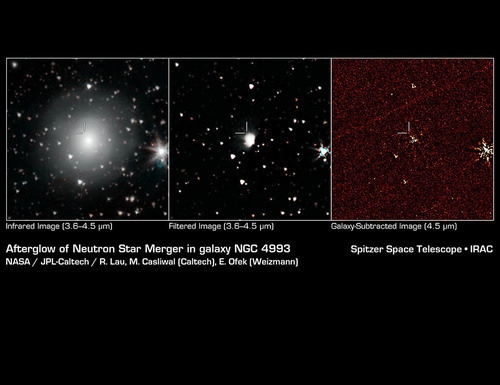
|
These Spitzer images show the afterglow of the neutron star merger GW170817 in NGC 4993.
Image credit: NASA/JPL-Caltech |
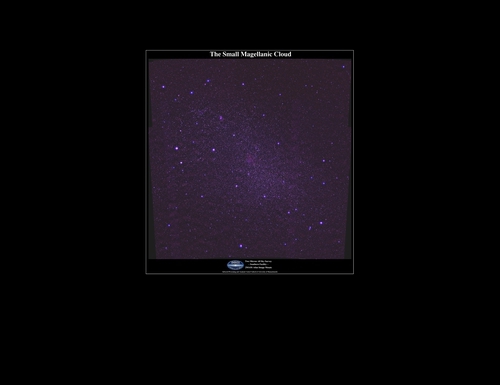
|
This 2MASS image shows the Small Magellanic Cloud. Much of the bar structure can still be seen, and the bright HII region, NGC 346, is prominent. The near-infrared light is dominated by cool, red supergiant and lower-mass red giant stars.
Image credit: T. Jarrett (IPAC) |
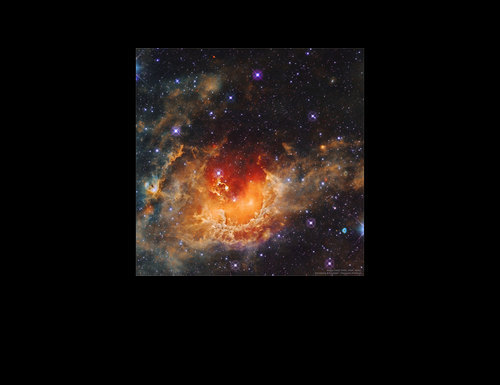
|
This image from WISE shows star formation in the Tadpole Nebula (IC 0410).
Image credit: WISE/IRSA/NASA/F. Antonucci |
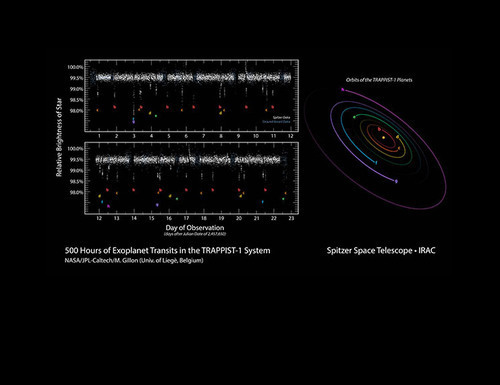
|
This figure shows 500 hours of Spitzer observations of the nearby ultracool dwarf star TRAPPIST-1. Transits of seven rocky planets (three of which lie in the habitable zone) are clearly visible.
Image credit: NASA/JPL-Caltech/M. Gillon (Univ. of Liege, Belgium) |
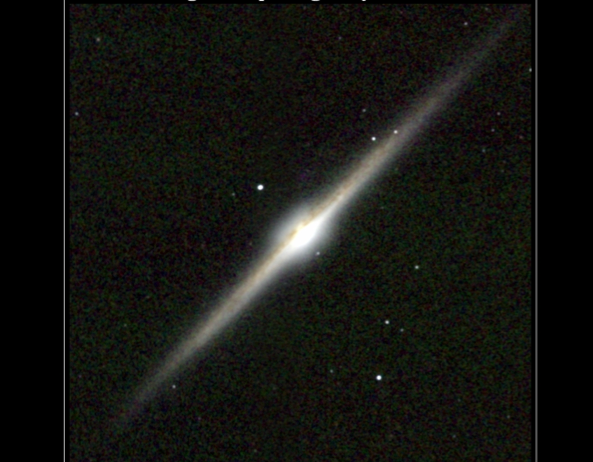
|
The edge-on spiral galaxy NGC 4565 is shown in this 2MASS image.
Image credit: S. van Dyk (IPAC) |
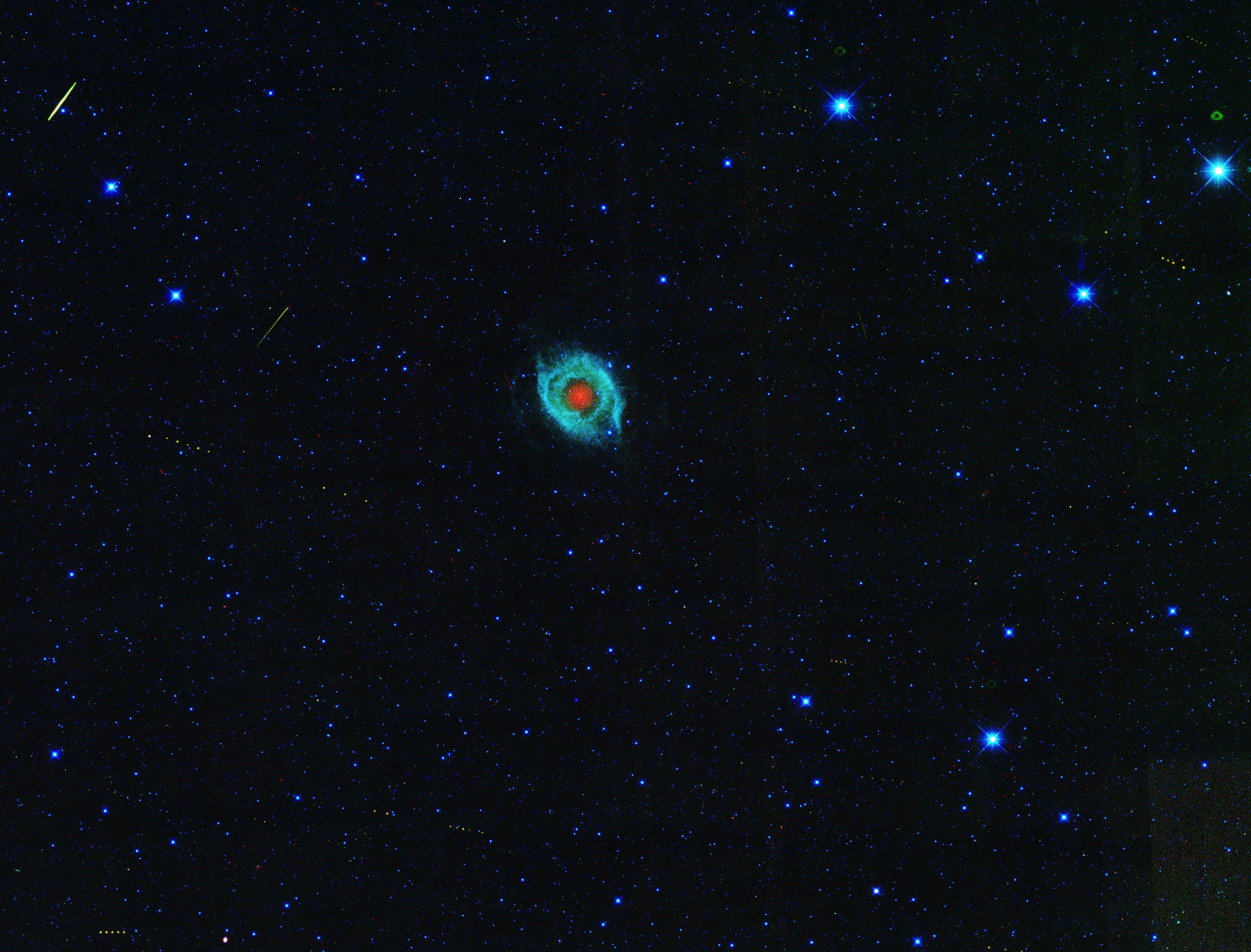
|
The Helix Nebula is surrounded by asteroid tracks in this WISE image.
Image credit: NASA/JPL-Caltech/UCLA |
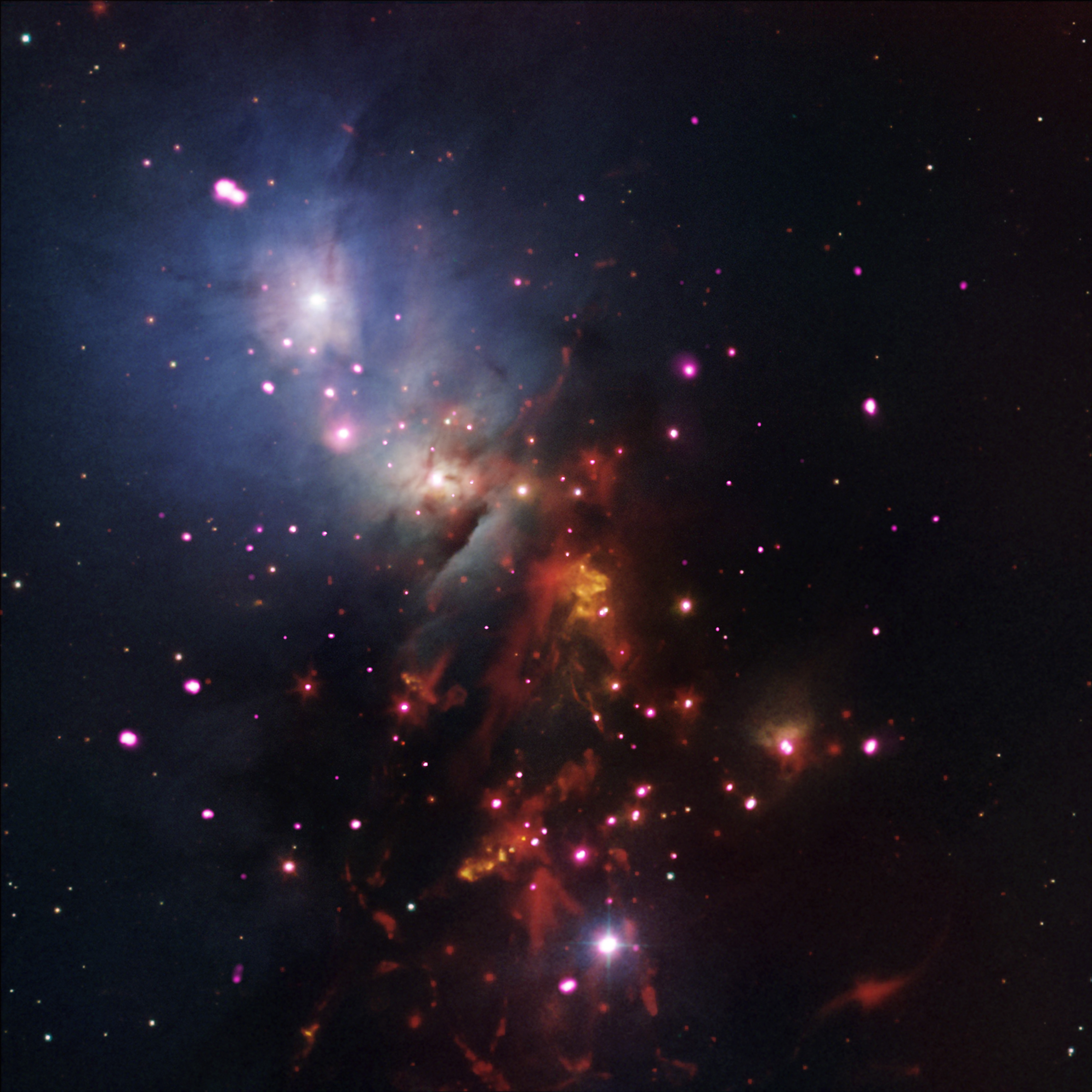
|
This image of NGC 1333 combines data from Spitzer (red), Chandra (pink), and the DSS.
Image credit: NASA/CXC/JPL-Caltech/NOAO/DSS |

|
This map shows the distribution of water in the stratosphere of Jupiter as measured with Herschel. The map has been
superimposed over an image of Jupiter at visible wavelengths taken with Hubble. The distribution of water is asymmetric with greater abundance in
the southern hemisphere. Based on this and other evidence, 95% of the water in Jupiter's stratosphere is believed to have come from the impact of comet Shoemaker-Levy 9 in 1994.
Image credit: Water map: ESA/Herschel/T. Cavali et al.; Jupiter image: NASA/ESA/Reta Beebe (NMSU) |
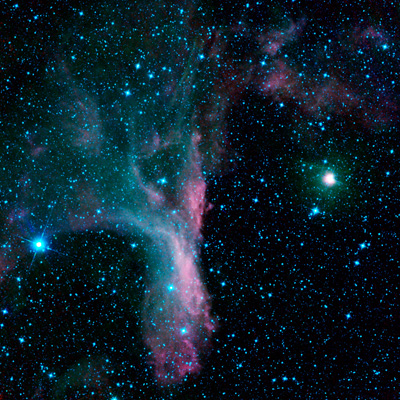
|
This WISE 3-band image shows the reflection nebula DG129 and the triple-star system Pi Scorpii (right).
Image credit: NASA/JPL-Caltech/WISE Team |
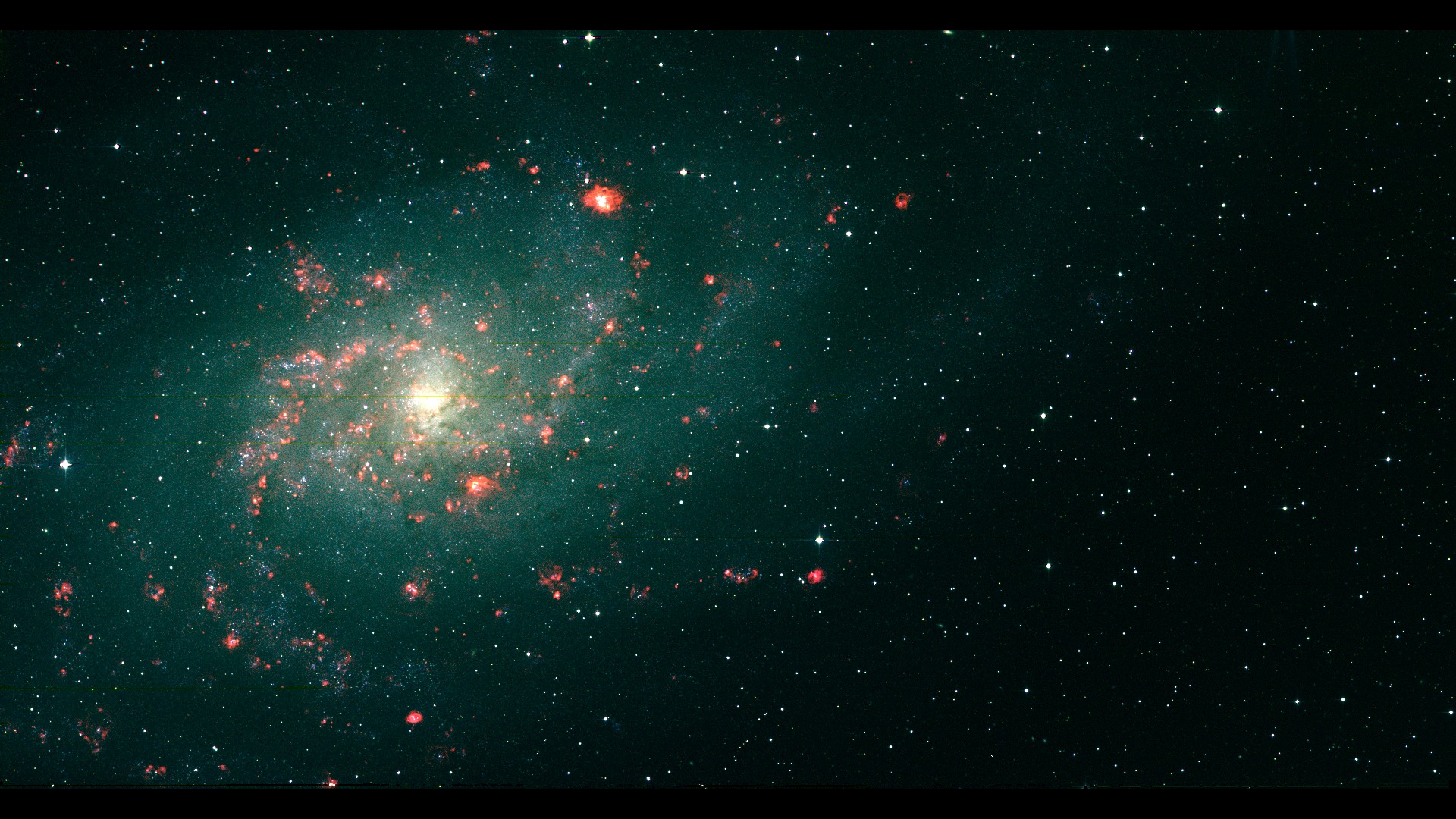
|
This Palomar Transient Factory image shows M33 in H-alpha (red), R (green), and g (blue).
Image credit: A. Waszczak |
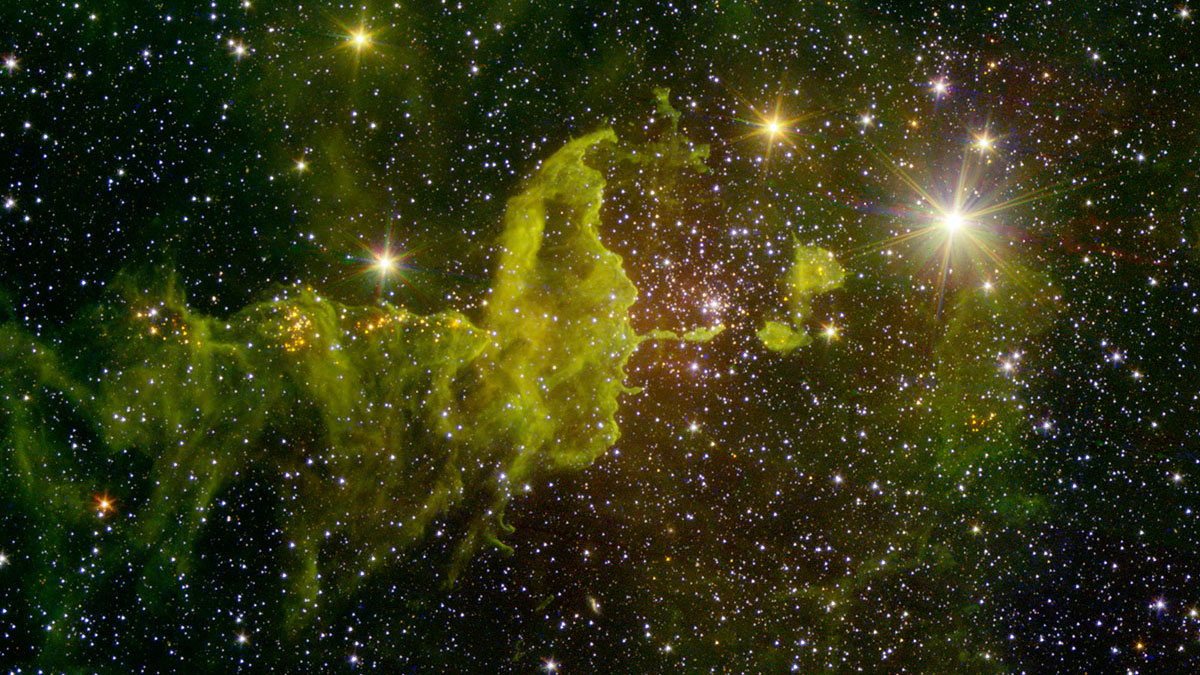
|
This Spitzer/2MASS mosaic shows IC 417 (Spider nebula). A 2015 NASA/IPAC Teacher Archive Research Program project focused on identifying new stars in the nebula.
Image credit: NASA/JPL-Caltech/2MASS |
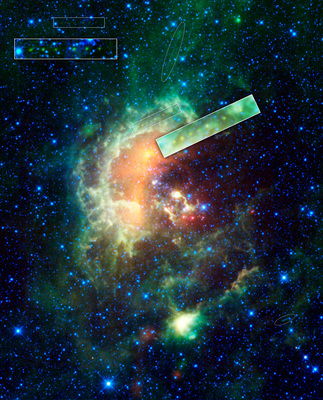
|
WISE image of the Tadpole Nebula, with asteroids 1719 Jens (center) and 1992 UZ5 (upper left) highlighted. The streak at top center is a satellite.
Image credit: NASA/JPL-Caltech |
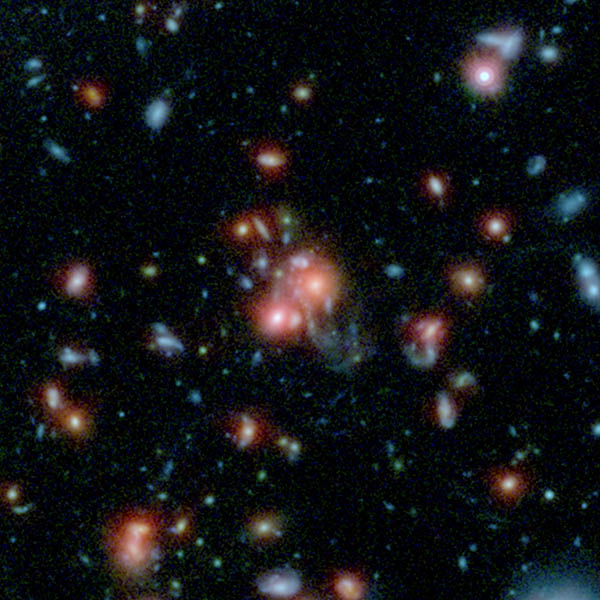
|
A merger between gas-rich galaxies triggered star formation in the center of the galaxy cluster SpARCS1049+56.
A tidal tail extends below the central cluster galaxy. This image shows Spitzer IRAC 3.6 μm in red, and HST WFC3 1.1 and 1.6 μm in blue and green.
Image credit: NASA/ESA/STScI/JPL-Caltech/McGill |

|
The HG-WELS team in the NASA/IPAC Teacher Archive Research Program
(NITARP) used a wide variety of IRSA data sets and tools to identify IR excesses around giant stars,
recently published in AJ.
Image credit: L. Rebull (IPAC) |
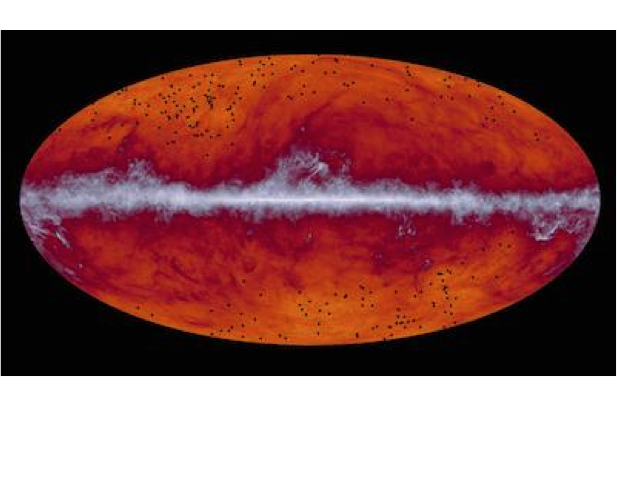
|
Galaxy clusters discovered by Planck are shown as black dots on this all sky map.
Image credit: ESA/Planck Collaboration/Dole, Guery, & Hurier, IAS/U. Paris-Sud/CNRS/CNES |
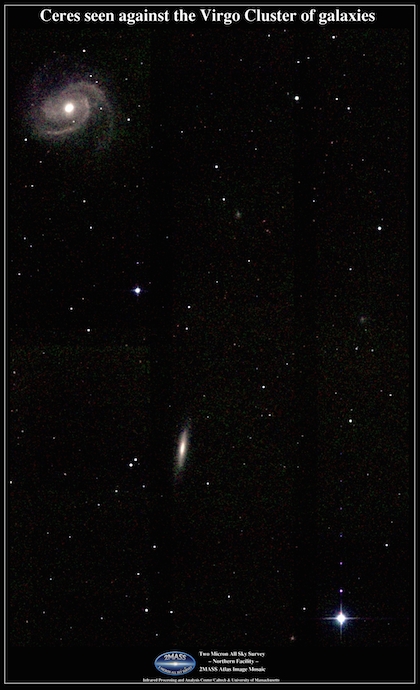
|
Ceres is seen against the Virgo Cluster of galaxies in this 2MASS mosaic. The spiral galaxy M100 is at the upper left.
Image credit: IPAC |
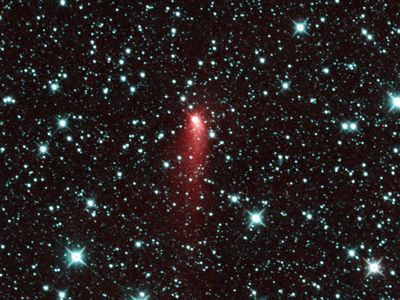
|
Comet C/2013 UQ4 (Catalina) was observed by NEOWISE just one day after its closest approach to the sun. The comet glows brightly in infrared wavelengths, with a dust tail streaking more than 62,000 miles (100,000 kilometers) across the sky. C/2013 UQ4 takes more than 450 years to orbit the sun in a retrograde orbit. The comet was originally thought to be an asteroid, as it appeared inactive when discovered in October 2013.
Image credit: NASA/JPL-Caltech |
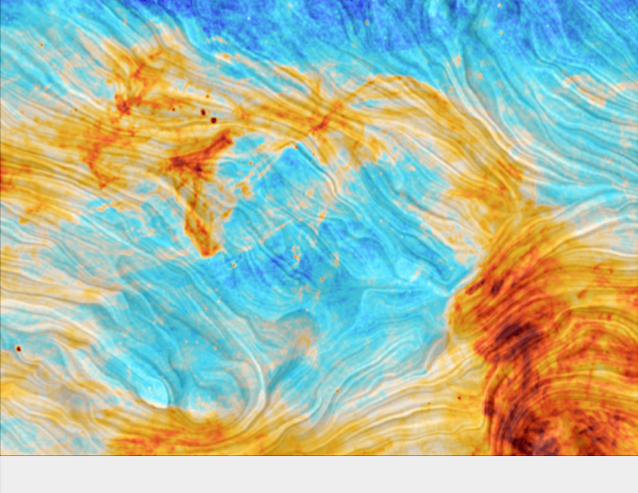
|
Planck visualization showing dust temperature as color, with magnetic polarization shown as the relief map.
Image credit: ESA/Planck Collaboration |

|
NGC4258 as seen by NASA's Great Observatories. This composite of Chandra X-ray data, Hubble optical data, Spitzer infrared data, and VLA radio data shows huge bubbles of hot gas above and below the plane of the galaxy. NGC4258 is part of the LVL Spitzer Legacy Program.
Image credit: NASA/CXC/JPL-Caltech/STScI/NSF/NRAO/VLA |
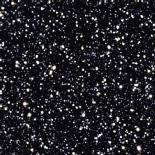
|
2MASS mosaic of part of Baade's Window, an important low-extinction field for observing the bulge of the Milky Way. This mosaic covers 0.64 by 1.15 degrees.
Other data sets at IRSA covering this field include the Spitzer GLIMPSE program and the BRAVA contributed data set.
Image credit: S. Van Dyk (IPAC) |
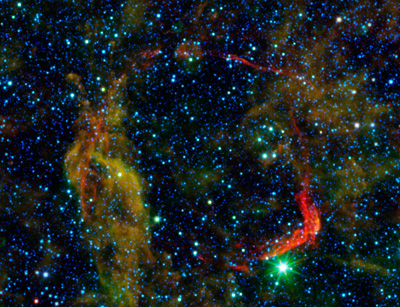
|
This image combines WISE and
Spitzer data to show dust associated
with the blast wave from RCW 86. The supernova was recorded by Chinese astronomers
in 185 AD, making it the oldest documented supernova.
Image credit: NASA/JPL-Caltech/UCLA |
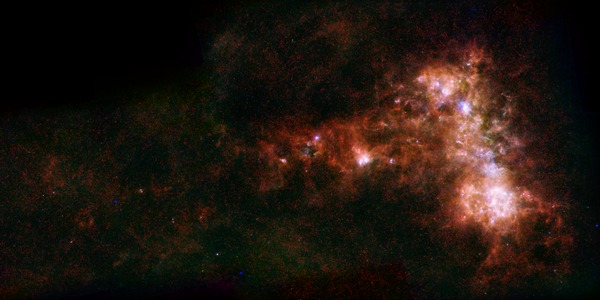
|
This image of the Small Magellanic Cloud combines Herschel
(100, 160, and 250 micron) data from the HERITAGE key program with
Spitzer (24, 70 micron) data from the SAGE
Legacy program. A stream of dust extends to the left in this image, known as the galaxy's "wing," and a bar of star formation appears on the right.
Image credit: ESA/NASA/JPL-Caltech/STScI |
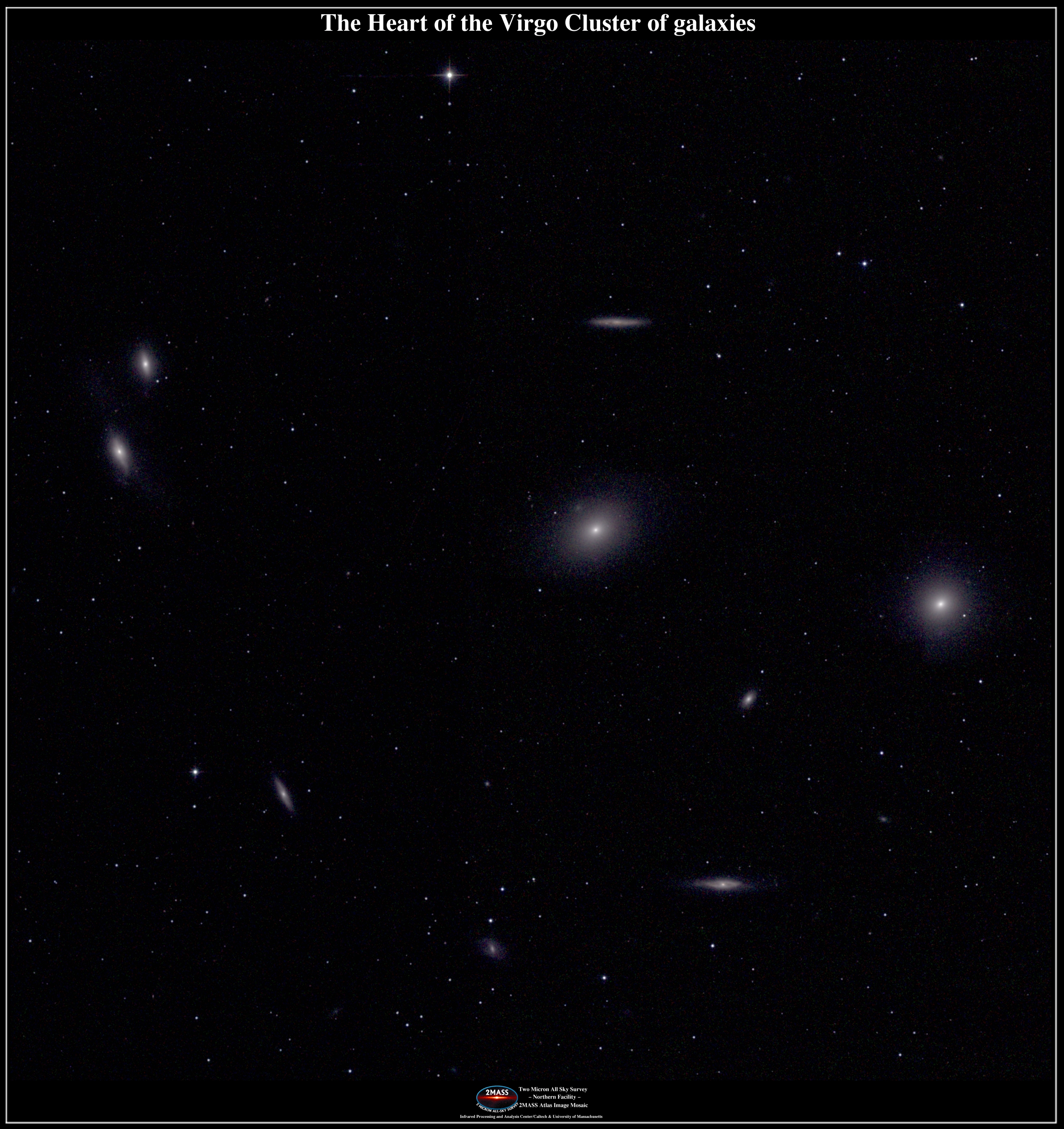
|
This 2MASS Atlas Image Mosaic shows the heart of the Virgo Cluster
of galaxies. This famous galaxy cluster, seen toward the constellation Virgo and covering in total more
than 7 degrees on the sky, is the closest large cluster to us, at a distance of about 17 Mpc. This
50' by 50' field includes M86 and M84 (center right).
Image credit: T. Jarrett (IPAC) |
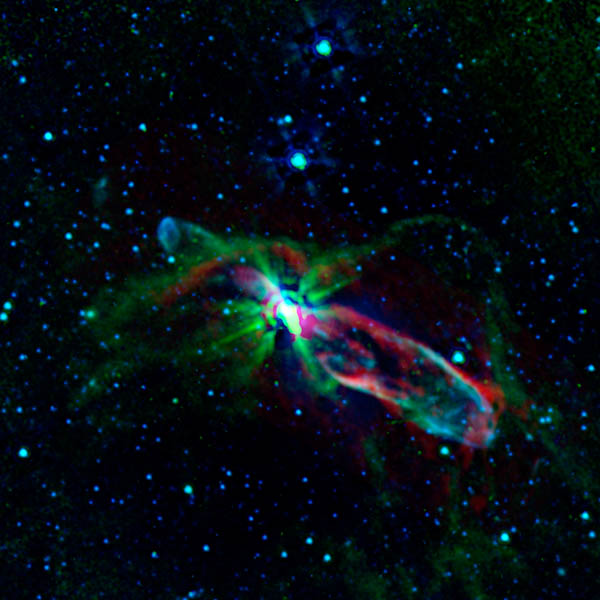
|
In this Spitzer and ALMA image of HH46/47, blue shows gas energized by the
outflowing jets. The green colors trace a combination of hydrogen gas molecules and dust that follows the boundary
of the gas cloud cocooning the young star. The reddish-colored areas, created by excited carbon monoxide gas, reveal
that the gas in the two lobes blown out by the star's jets is expanding faster than previously thought.
Image credit: NASA/JPL-Caltech/ALMA |

|
WISE image of the Witch Head Nebula (IC 2118).
The Witch Head Nebula is estimated to be hundreds of light-years away in the Orion constellation, just off the famous hunter's knee.
Image credit: NASA/JPL-Caltech/WISE Team |
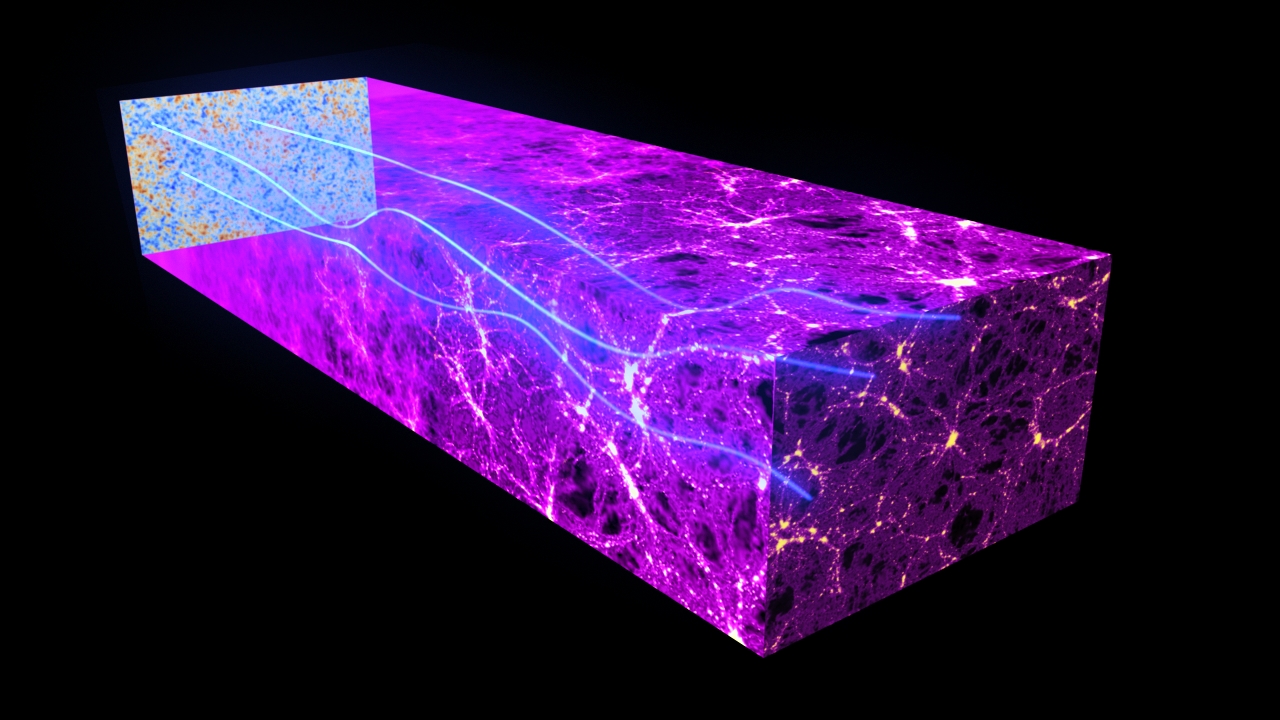
|
The image shows the background light from the Big Bang being lensed by foreground dark matter structure which
is located between us and the epoch at which the Universe became transparent. The
Planck mission concludes operations on 23 October 2013.
Image credit: ESA and the Planck collaboration |
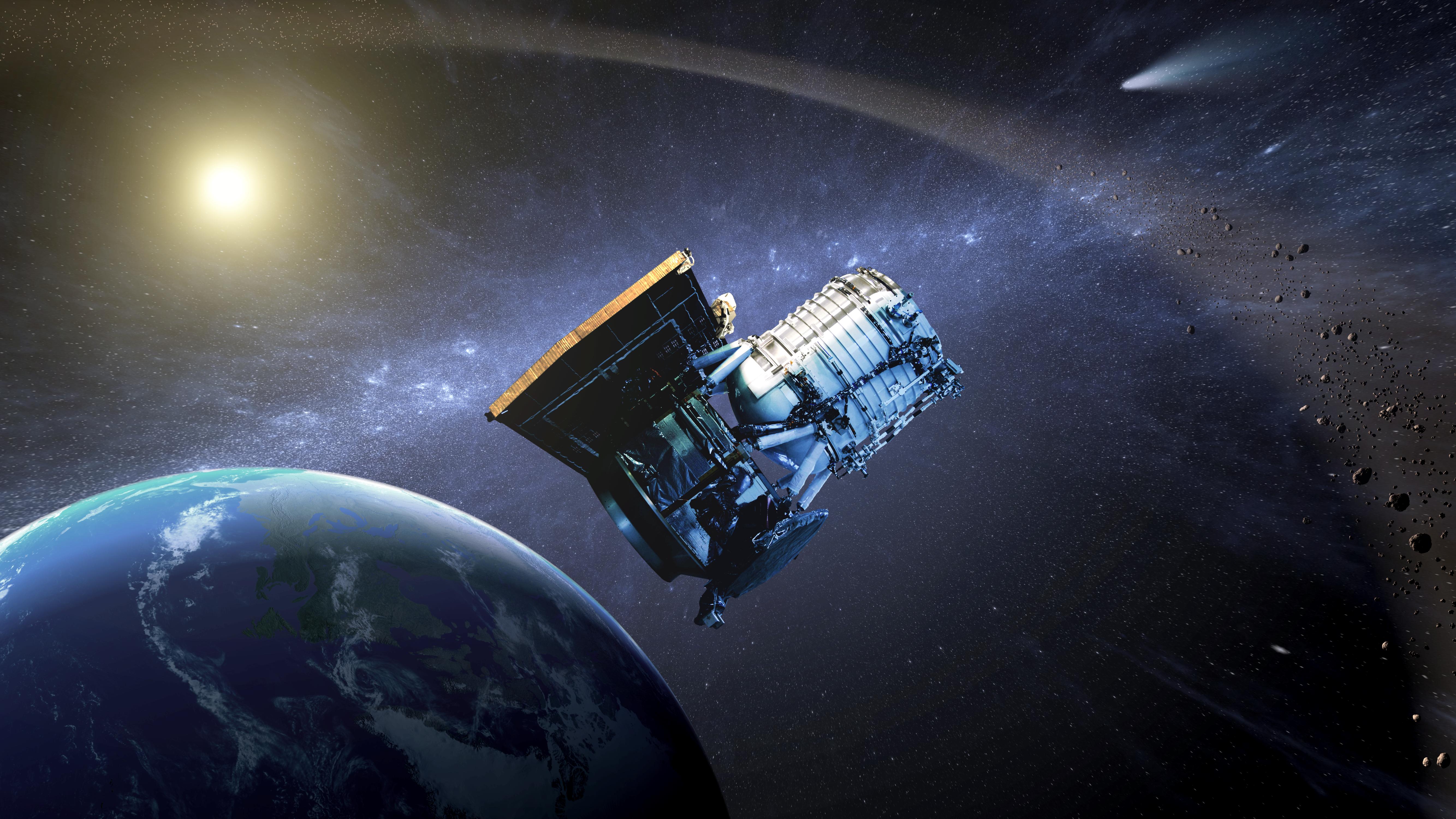
|
This artist's concept shows the Wide-field Infrared Survey Explorer, or WISE spacecraft,
in its orbit around Earth. In September of 2013, engineers will attempt to bring the mission out of hibernation to hunt for more asteroids and comets in a project called NEOWISE.
From 2010 to 2011, the WISE mission scanned the sky twice in infrared light not just for asteroids and comets but also stars, galaxies and other objects. Back then, the asteroid-hunting portion of the mission was named NEOWISE, which combines the acronyms for near-Earth objects (NEOs) and WISE. NEOs are those asteroids with orbits that come relatively close to Earth. Now, in its second "lease on life," the mission will be dedicated to asteroid and comet surveying. Image credit: NASA/JPL-Caltech |
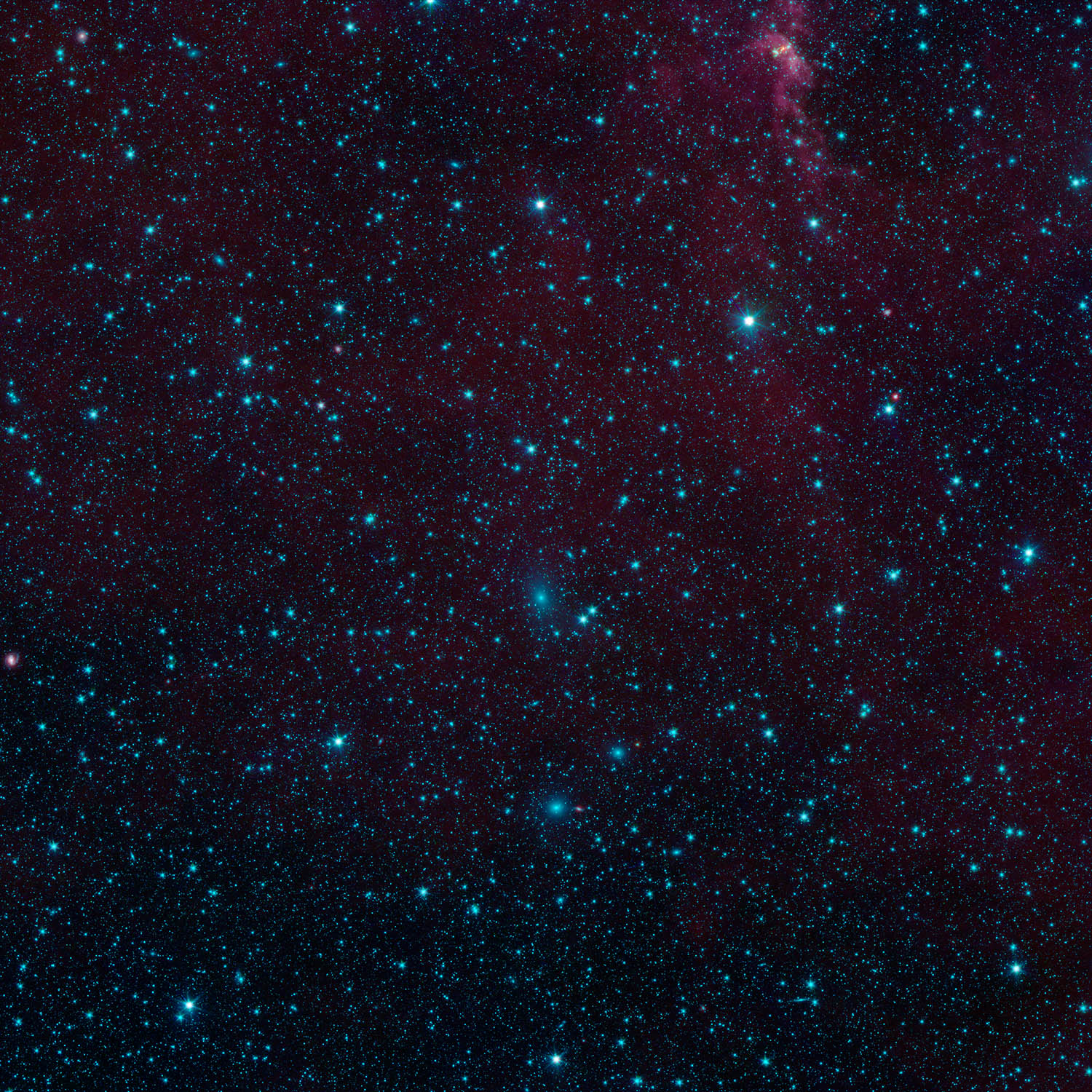
|
There are nearly 200 galaxies in this image from Spitzer.
These are part of the Perseus-Pisces supercluster of galaxies located 250 million light-years
away. Normally, galaxies beyond our Milky Way are hidden from view when they happen to fall
behind the plane of our galaxy. This is due to foreground dust standing in the way. Spitzer's Galactic Legacy Infrared Mid-Plane Survey Extraordinaire 360, or Glimpse 360 project, is pointing Spitzer away from the galactic center, to complete a full 360-degree scan of the Milky Way plane. It has captures many images in the process, such as this one, revealing hidden objects. Image credit: NASA/JPL-Caltech/University of Wisconsin |
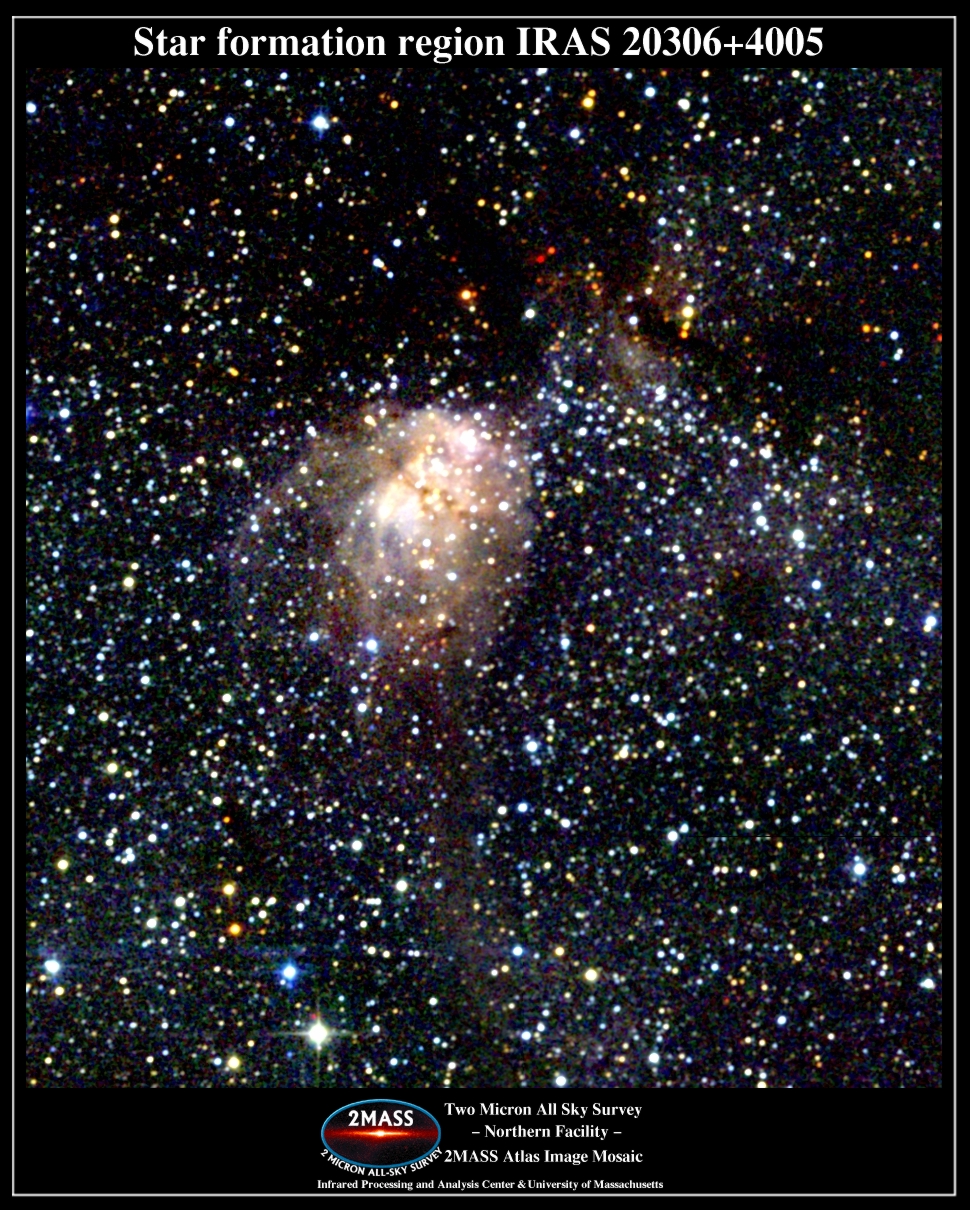
|
2MASS image of IRAS 20306+4005, an object in the Infrared Astronomical Satellite (IRAS)
catalog of sources. Little is known about this object, but it appears to be a region of current massive star formation in
the Galactic plane and near the Cygnus 0B2 stellar association. This is the first known near-infrared image of this source.
Infrared-bright filaments of gas surround a young cluster of stars and young stellar objects still embedded in their natal
dusty molecular cloud. A large patch of heavily-obscuring dust is seen to the north of the nebula. 2MASS is ideal for
investigating the nature of many IRAS objects and other very young star-forming regions throughout the Galaxy.
Image credit: S. Van Dyk (IPAC) |
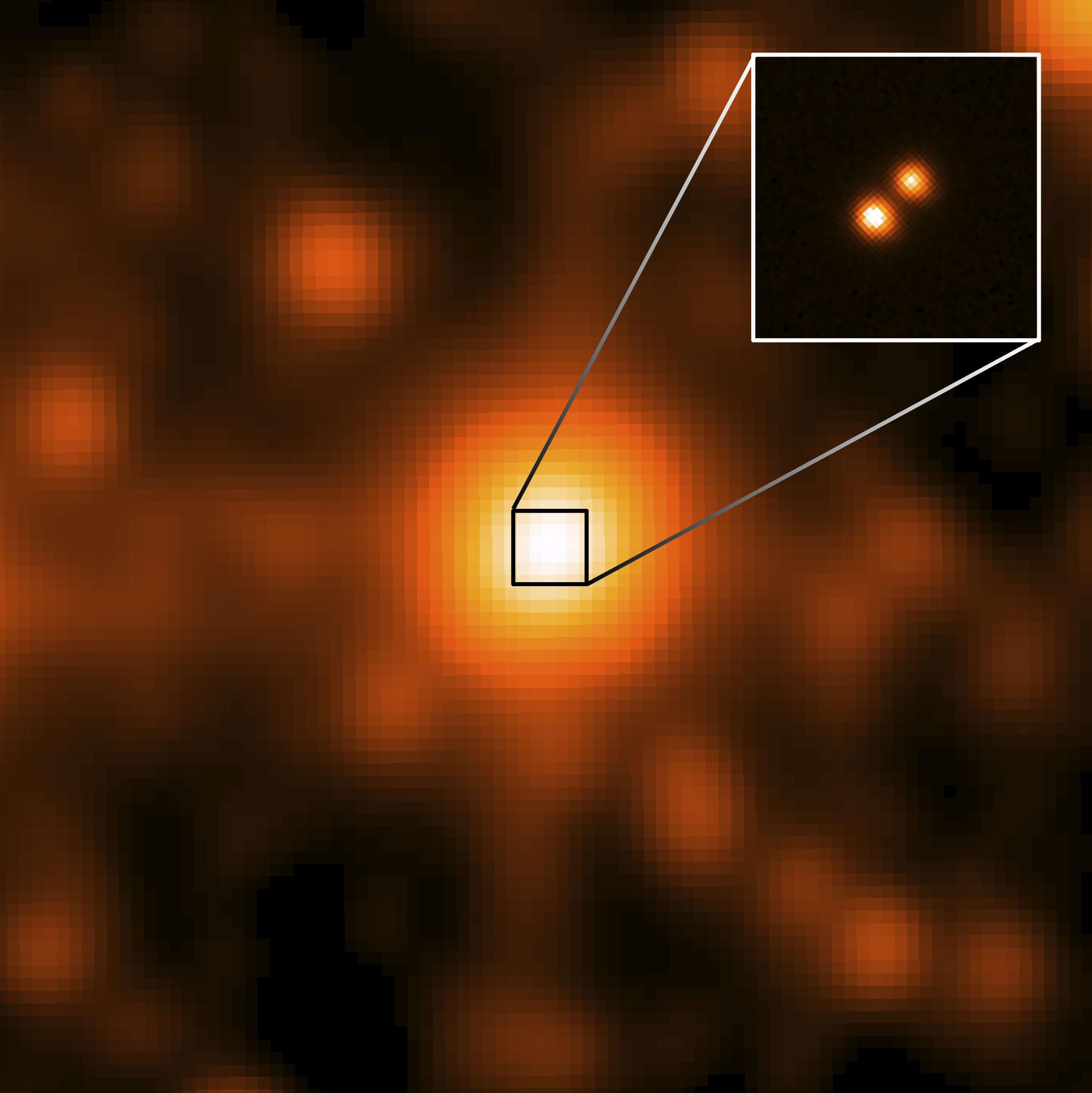
|
WISE J104915.57-531906 is at the center of the larger image, which was taken by the NASA's Wide-field Infrared Survey Explorer
(WISE). This is the closest star system discovered since 1916, and the third closest to our sun.
It is 6.5 light-years away. At first, the light appeared to be from a single object, but a sharper image (inset) from Gemini Observatory
in Chile revealed that it was from a pair of cool star-like bodies called brown dwarfs.
Image credit: NASA/JPL-Caltech/Gemini Observatory/AURA/NSF |
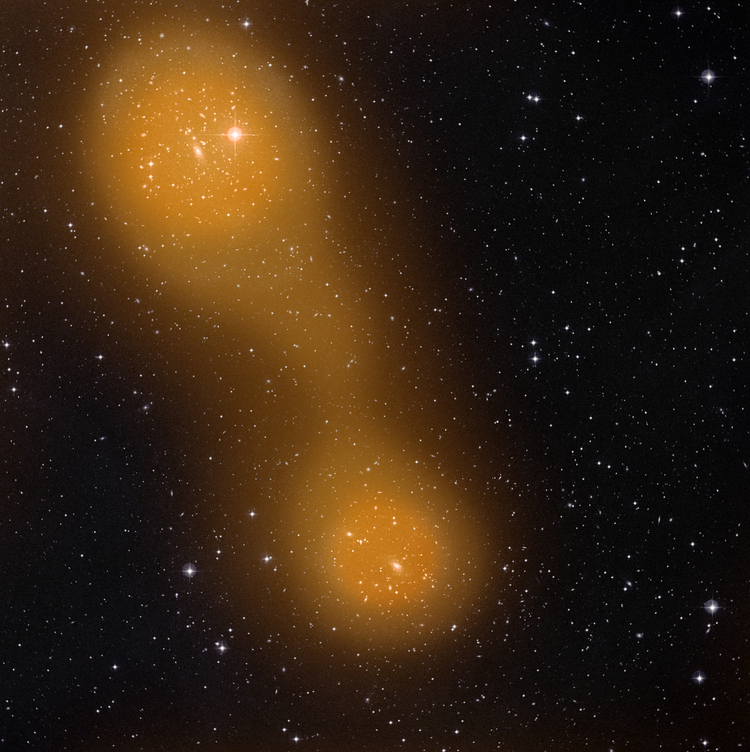
|
This image shows Planck's first detection of intercluster gas using the SZ effect.
The 10 million light year long bridge of hot gas connects the galaxy clusters Abell 401 (upper left) and Abell 399
(lower center), at a redshift of 0.07.
Image credit: ESA Planck Collaboration and STScI Digitized Sky Survey |
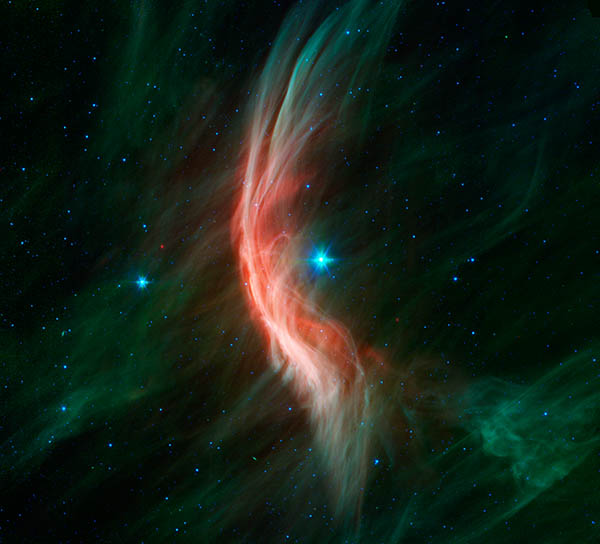
|
The giant star Zeta Ophiuchi is having a "shocking" effect on the surrounding dust clouds in this Spitzer image.
Zeta Ophiuchi is a young, large and hot star located around 370 light-years away. It dwarfs our own sun in many ways -- it is about six times hotter, eight
times wider, 20 times more massive, and about 80,000 times as bright. It would be one of the brightest stars in the sky were it not largely obscured by foreground dust clouds. This massive star is travelling at a snappy pace of about 54,000 mph (24 kilometers per second), fast enough to break the sound barrier in the surrounding interstellar material. Because of this motion, it creates a spectacular bow shock ahead of its direction of travel (to the left). Image credit: NASA/JPL-Caltech |
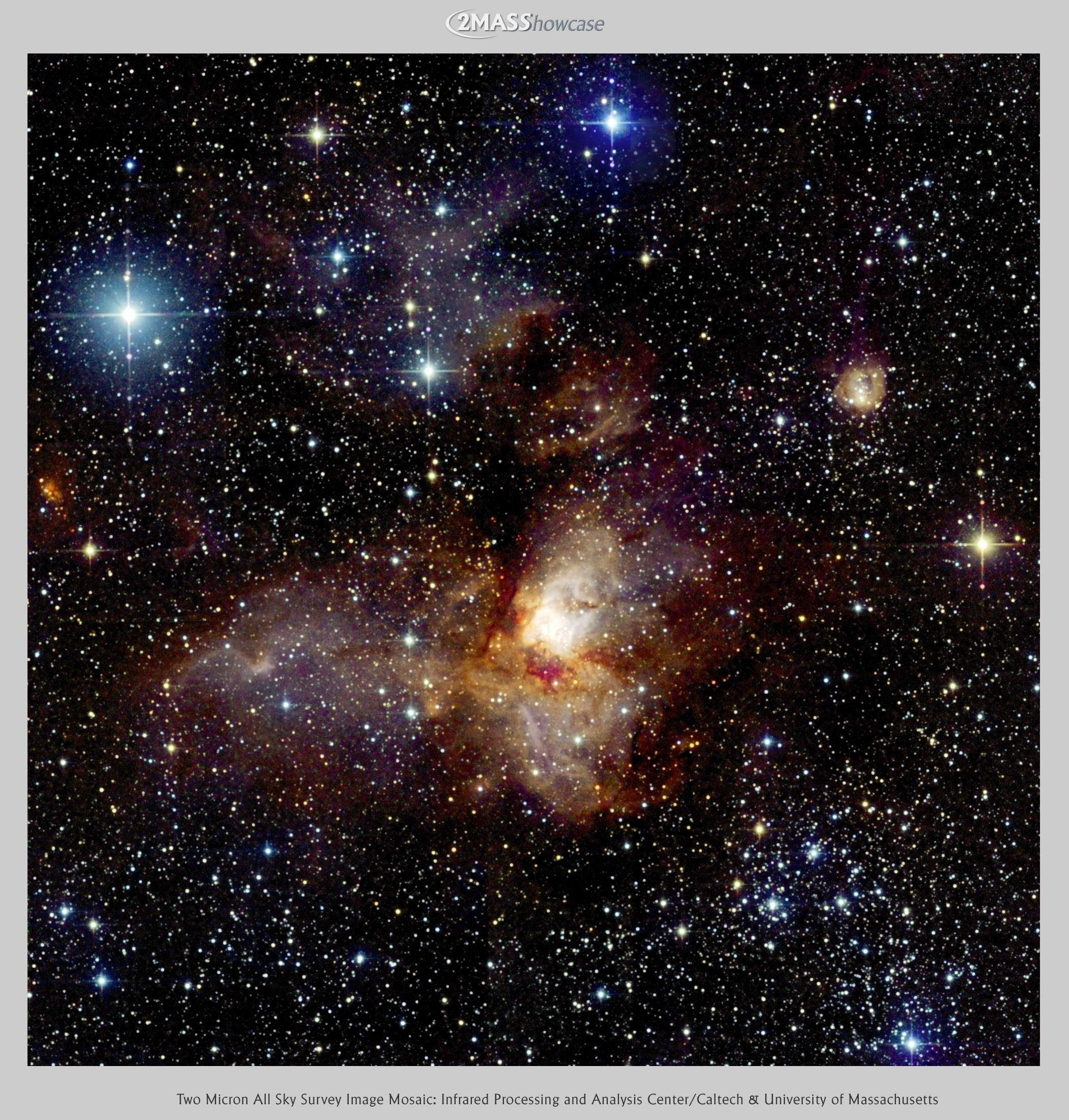
|
RCW 38 is at a distance of ~1.7 kpc (~5500 light years) from us, near the famous Vela supernova remnant and the Gum nebula.
This starforming region contains a number of highly massive O stars embedded in a dense obscuring cloud. The stars are
about 2 million years old, indicating that star formation is ongoing is this relatively young region. As seen in the
2MASS near-infrared Image mosaic, the nebulosity associated with RCW 38 is extensive across
a large area, with dust lanes and patches running throughout. Other, smaller obscured star-forming regions are nearby, with
less-obscured young, massive stars and associated reflection nebulae also in the field.
Image credit: 2MASS/R. Hurt |
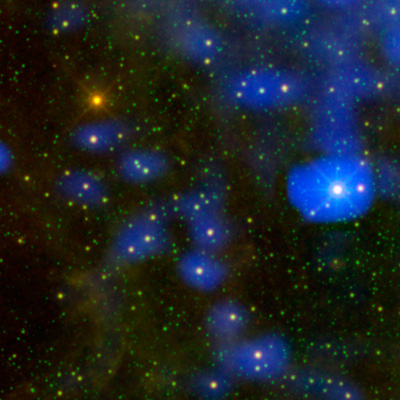
|
This image of the dusty star WISE J180956.27-330500.2 (the orange star in the upper left) compares WISE
12- and 22-micron data (green and red, respectively) with IRAS 12 micron
data (blue). The star has brightened by a factor of 100 between the IRAS and WISE observations. This appears to
have been caused by a sudden eruption in the star around 15 years ago. Dust freshly created in this event
is heated by starlight and glows at infrared wavelengths.
Image credit: NASA/JPL-Caltech |
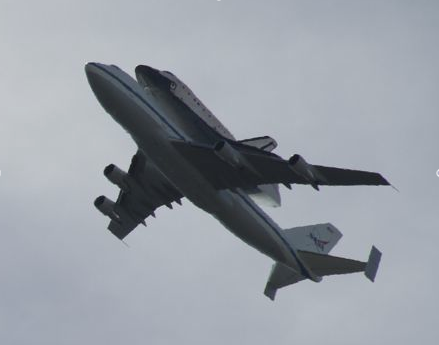
|
The Space Shuttle Endeavour flies over IPAC. Endeavour's support of the missions archived at IRSA includes
flying the first of the Hubble servicing missions in December 1993
(HST data are a key component of the COSMOS project) and recovering the
IRTS in January 1996.
Image credit: J. Llamas (IPAC) |
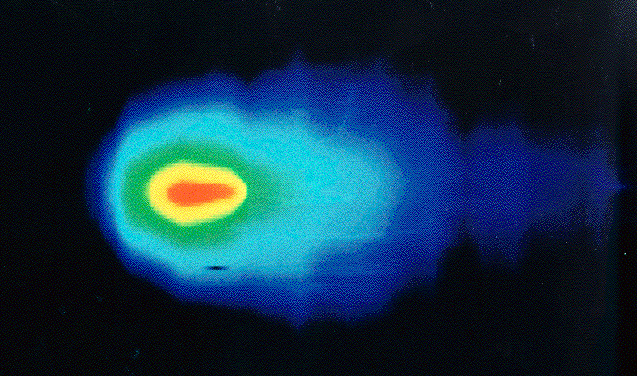
|
Comet IRAS-Araki-Alcock was discovered by the Infrared Astronomical Satellite (IRAS) and
made the closest known approach to earth of any comet within the last 200 years. This color image shows part of the 200,000 km
long tail of warm dust stretching out behind the comet. In this image, made at a wavelength of 25 microns, the bright red area
represents the unresolved nucleus of the comet, while the fainter emission from the tail of the comet is yellow and blue.
Image credit: IPAC |
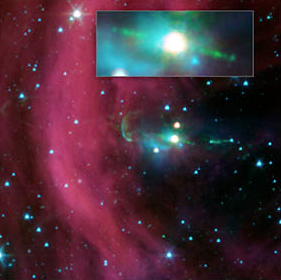
|
Spitzer image of Herbig-Haro 34. This image shows two jets (green = 4.5 micron); the
jet on the left is buried behind a dark cloud, and thus cannot be seen in visible-light images. This image shows that
both of the twin jets are made up of identical knots of gas and dust, ejected one after another from the area around the
star. By studying the spacing of these knots, and knowing the speed of the jets from previous studies, astronomers were
able to determine that the visible jet (to the right of the star) punches its material out 4.5 years later than the counter-jet.
Image credit: NASA / JPL-Caltech / A. Raga (ICN/UNAM) & A. Noriega-Crespo (SSC/Caltech) |
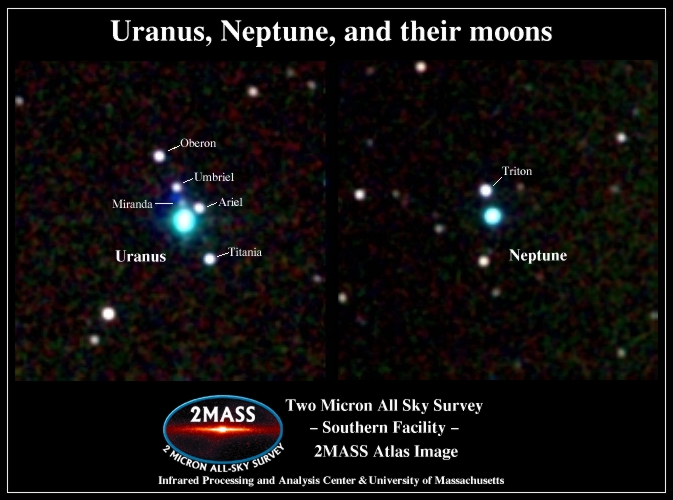
|
2MASS images of Uranus, Neptune, and their moons. Uranus and Neptune were observed serendipitously by
the 2MASS Southern Facility, during routine operations on 1998 June 7 and June 11 UT, respectively. Both planets appear very blue, i.e.,
they are not nearly as bright in the Ks band as in the shorter wavelength bands, due to more reflection of sunlight at short wavelengths
and to absorption of light by methane gas in their atmospheres.
Image credit: B. Nelson (IPAC) |
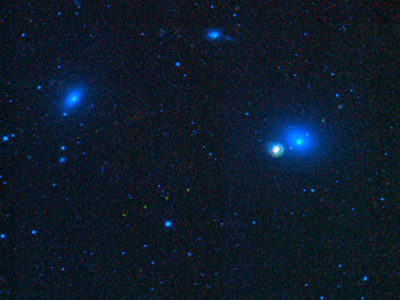
|
This image from WISE shows four galaxies in the Virgo cluster:
Messier 59, Messier 60, NGC4647, and NGC4638. It also shows the tracks of three asteroids, which
appear in this image as trails of green dots.
Image credit: NASA/JPL-Caltech/WISE Team |
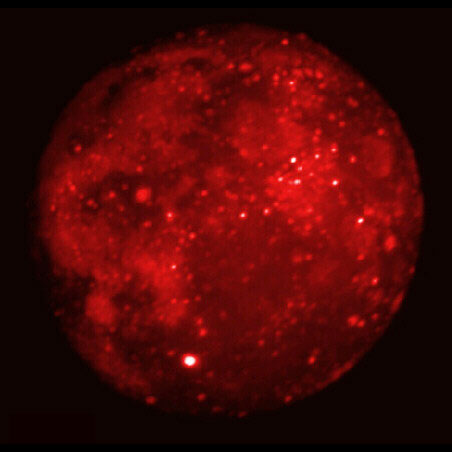
|
The Moon as seen in the mid-IR by MSX.
Image credit: DCATT Team, MSX Project, BMDO |
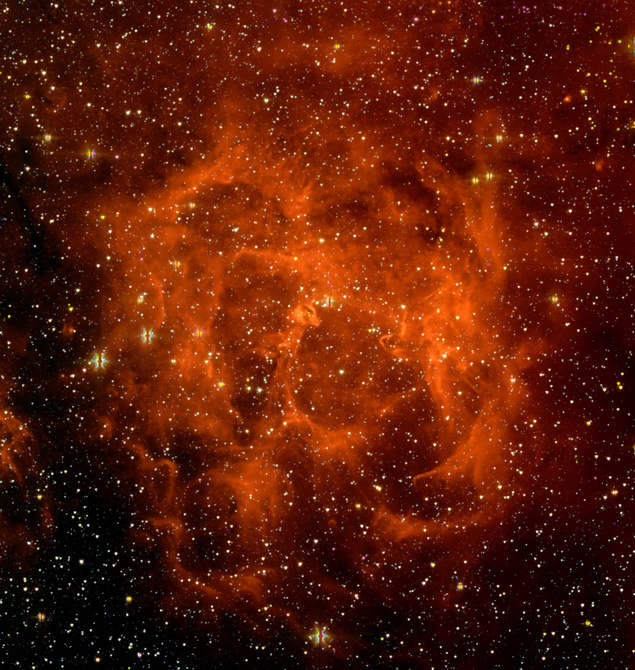
|
A portion of the Triffid Nebula from the Spitzer Enhanced Imaging Super Mosaics.
Image credit: J. Llamas (IPAC) |

|
WISE has discovered the coldest known brown dwarf, WISE 1828+2650, shown in green on this image.
WISE 1828+2650 is a Y dwarf with a temperature less than 80 degrees Fahrenheit (25 degrees Celsius). Image credit: NASA/JPL-Caltech/UCLA |
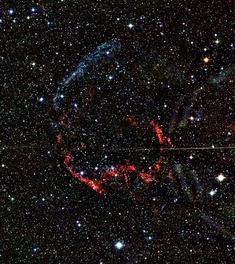
|
This false-color 2MASS mosaic shows the intermediate-age Galactic supernova remnant IC 443, which is at a distance of about 1.5 kpc. What can be seen over this large area are two regions of near-infrared emission from the remnant. The bright bluish arc to the northeast appears to be line emission from excited iron in these remnant filaments, bright in the J band. Along the south, from east to west, is the interaction of the remnant with the nearby molecular cloud. The supernova shock is exciting 2.12-micron H_2 molecular line emission, very bright in the Ks band. Image credit: E. Kopan (IPAC). |
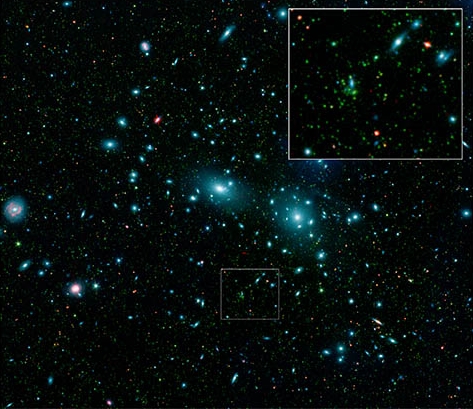
|
This false-color mosaic of the central region of the Coma cluster combines infrared and visible-light images to reveal thousands of faint objects (green). Follow-up observations showed that many of these objects, which appear here as faint green smudges, are dwarf galaxies belonging to the cluster. Two large elliptical galaxies, NGC 4889 and NGC 4874, dominate the cluster's center. The mosaic combines visible-light data from the Sloan Digital Sky Survey (color coded blue) with long- and short-wavelength infrared views (red and green, respectively) from NASA's Spitzer Space Telescope. Image credit: NASA/JPL-Caltech/L. Jenkins (GSFC) |
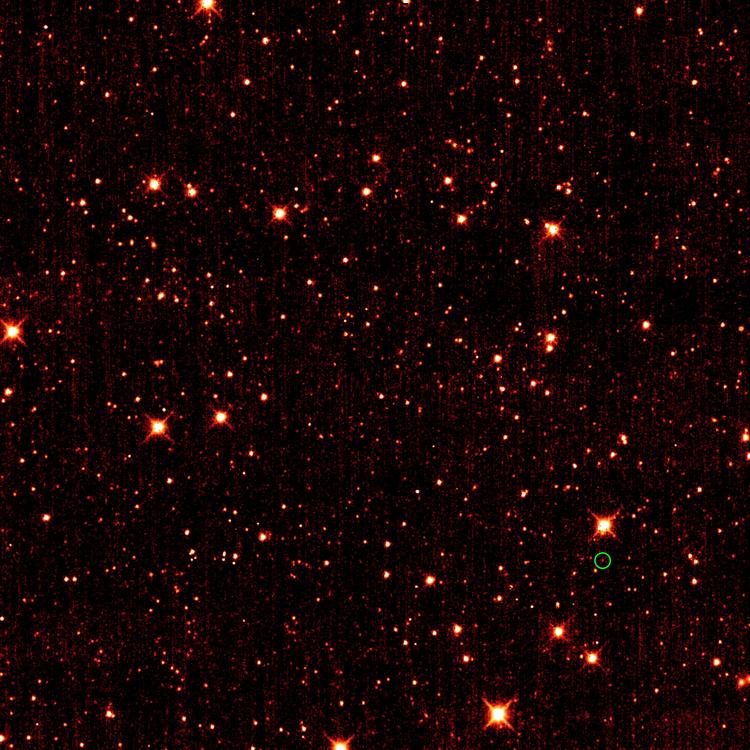
|
WISE recently discovered the first Earth Trojan asteroid. Asteroid 2010 TK7 is circled in green, while the majority of the other dots are stars or galaxies far beyond our solar system. This image was taken in infrared light at a wavelength of 4.6 microns in Oct. 2010. Image credit: NASA/JPL-Caltech/UCLA |
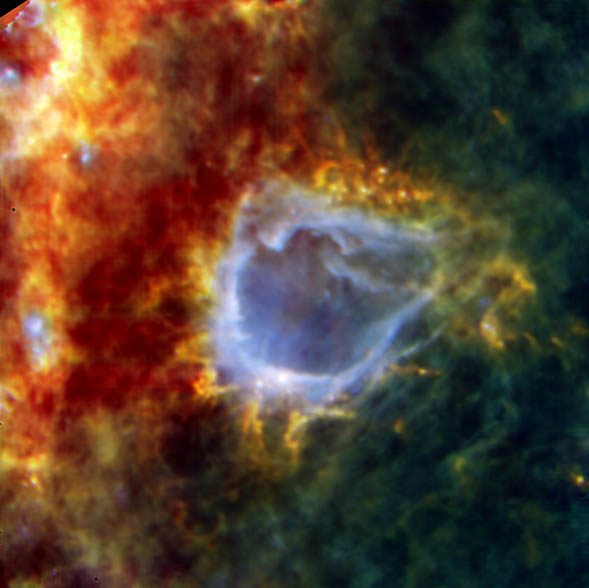
|
Herschel's observation of the star-forming cloud RCW 120 has revealed an embryonic star which looks set to turn into one of the biggest and brightest stars in our Galaxy within the next few hundred thousand years. It already contains eight to ten times the mass of the Sun and is still surrounded by an additional 2000 solar masses of gas and dust from which it can feed further. IRSA will provide seamless access to the Herschel archive as well as curation of Key Project enhanced products. Image credit: ESA/PACS/SPIRE/HOBYS Consortia |

|
NGC 2024, also known as the Flame Nebula, is located at a distance of 400-500 pc and is part of the Orion Molecular Cloud Complex (Orion B). To the south of the NGC 2024 region lies NGC 2023 (a well-studied photo-dissociation region) and the Horsehead Nebula. At near-infrared wavelengths as shown in this 2MASS image, a dense stellar cluster is revealed in the dark lane separating the two halves of the flame. Image credit: E. Kopan and R. Hurt (IPAC) |

|
Maffei 2 is the poster child for an infrared galaxy that is almost invisible to optical telescopes. Foreground dust clouds in the Milky Way block about 99.5% of its visible light, but this infrared image from NASAs Spitzer Space Telescope penetrates this dust to reveal the galaxy in all its glory. This Spitzer image clearly shows the unusual structure of Maffei 2. The strong central bar and asymmetric spiral arms help identify why the galaxy also harbors a starburst in its very core. Such dramatic bursts of star formation occur when massive amounts of dust and gas are driven into the center of a galaxy, often by gravitational interactions that create barred spiral structures in its disk. Image credit: NASA/JPL-Caltech/J. Turner (UCLA) |

|
The planetary nebula NGC1514 as seen by WISE. The object is actually a pair of stars -- one star is a dying giant somewhat heavier and hotter than our sun, and the other was an even larger star that has now contracted into a white dwarf. As the giant star ages, it sheds some its outer layers of material to form a large bubble around the two stars. Jets of material from the white dwarf are thought to have smashed into this bubble wall. The areas where the jets hit the cavity walls appear as orange rings in the WISE image. In this image, 3.4 microns is blue; 4.6-micron light is cyan; 12-micron light is green; and 22-micron light is red. IRSA hosts the WISE archive, with the first public data release on April 14, 2011. Image credit: NASA/JPL-Caltech/UCLA |
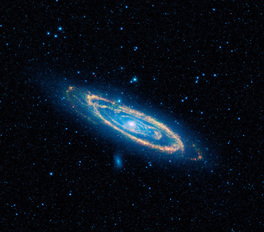
|
The immense Andromeda galaxy M31 is captured in full in this new image from NASA's Wide-field Infrared Survey Explorer (WISE). The mosaic covers an area of five degrees across the sky. WISE used all four of its infrared detectors to capture this picture (3.4- and 4.6-micron light is colored blue; 12-micron light is green; and 22-micron light is red). Blue highlights mature stars, while yellow and red show dust heated by newborn, massive stars. IRSA hosts the WISE archive, with the first public data release in April 2011. Image credit: NASA/JPL-Caltech/WISE Team |
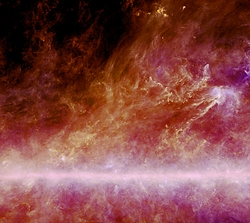
|
This image is a three-colour combination constructed from Planck's two highest frequency channels (557 and 857 GHz, corresponding to wavelengths of 540 and 350 micrometres), and an image at the shorter wavelength of 100 micrometres obtained with the Infrared Astronomical Satellite (IRAS). This combination effectively traces the dust: reddish tones correspond to temperatures as cold as 12 degrees above absolute zero, and whitish tones to significantly warmer ones (of order a few tens of degrees) in regions where massive stars are currently forming. Overall, the image shows local dust structures within 500 light years of the Sun. Image credit: ESA and the HFI Consortium, IRAS |
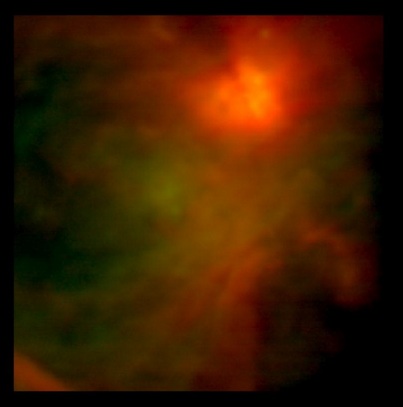
|
This infrared image of the heart of the Orion star-formation complex was taken from the Stratospheric Observatory for Infrared Astronomy (SOFIA) using the FORCAST mid-infrared camera during one of SOFIA's first science flights. The image is a two color composite (green - 20 microns, red - 37 microns). IRSA will host the SOFIA archive. Image credit: NASA/SOFIA/USRA/FORCAST Team |
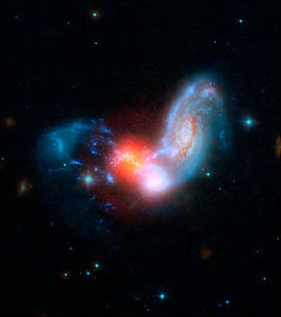
|
The merging galaxy system II Zw 096, shown here in a combination of HST and Spitzer data, contains a luminous off-nuclear starburst that produces 80 percent of the infrared light. This is the brightest off-nuclear starburst ever seen, and the star formation rate is approximately 100 solar masses per year. II Zw 096 is part of the GOALS Spitzer Legacy program. In this image, HST 0.15 micron SBC data and 0.44 micron ACS data are shown in blue, 0.9 micron ACS data are shown in cyan, Spitzer 4.5 micron IRAC data are shown in orange, and 8 micron IRAC and 24 micron MIPS data are shown in red. Image credit: NASA/JPL-Caltech/H. Inami (SSC/Caltech) |
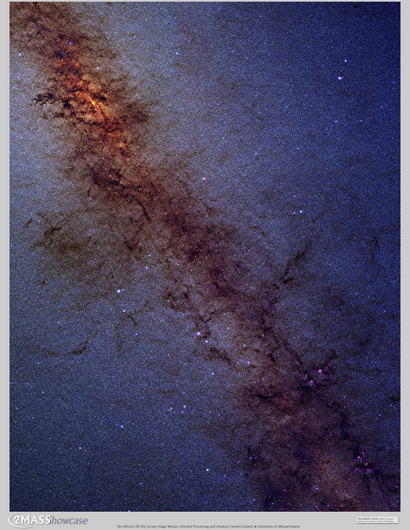
|
The Galactic Center as seen by 2MASS. This 8 degree by 10 degree image includes almost 10 million resolved stars. Image credit: 2MASS/G. Kopan, R. Hurt (IPAC/Caltech). |
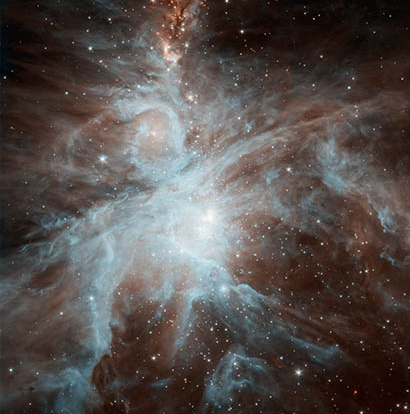
|
The Orion Nebula as seen by Spitzer's IRAC camera. The data were taken after the start of the Spitzer "warm" mission; blue shows 3.6 micron data and orange shows 4.5 micron data. The Spitzer Heritage Archive (SHA) contains all Spitzer data, including warm mission data. Image credit: NASA/JPL-Caltech/J. Stauffer (SSC/Caltech). |
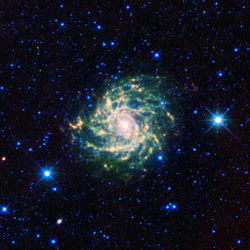
|
The galaxy IC 342 as seen by WISE. This galaxy is hidden behind the disk of the Milky Way at visual wavelengths, but can be clearly seen by WISE in the mid-infrared (3.4, 4.6, 12, and 22 microns). WISE achieved full coverage of the entire sky on 17 July 2010, and will continue to survey the sky until the cryogen runs out this fall. WISE data will be available through IRSA starting in Spring 2011. Image credit: NASA/JPL-Caltech/WISE Team. |
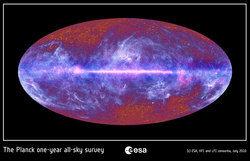
|
The first Planck all sky survey, covering one year of observations, shows the microwave sky from 30 to 857 GHz. IRSA will begin serving Planck's Early Release Compact Source Catalog in early 2011. Image credit: ESA, HFI, & LFI consortia. |
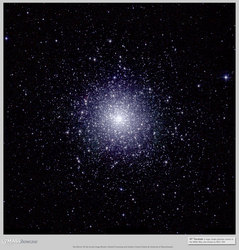
|
This 2MASS image of the globular cluster 47 Tucanae covers an area 34 arcminutes on a side. 47 Tuc is the second brightest globular cluster in the sky, and contains about a million stars 20,000 light years from Earth. Image credit: 2MASS/T. Jarrett (IPAC). |
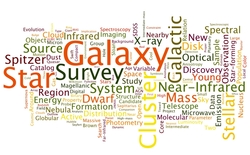
|
A Wordle of the titles of all papers citing IRSA services or datasets in the past six months (November 2009 - April 2010). IRSA continues to be cited by roughly 10% of all refereed astronomical journal articles, unchanged from previous years. The Wordle illustrates the breadth of scientific research making use of IRSA. Image credit: J. Howell (IRSA). |
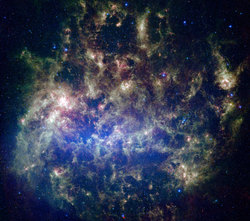
|
This Spitzer mosaic of the Large Magellanic Cloud was created as part of the "Surveying the Agents of a Galaxy's Evolution" (SAGE) legacy program. In this three color composite covering more than seven degrees on a side, blue is 3.6 microns, green is 8 microns, and red is 24 microns. Image credit: NASA/JPL-Caltech/M. Meixner (STScI) & the SAGE Legacy Team. |
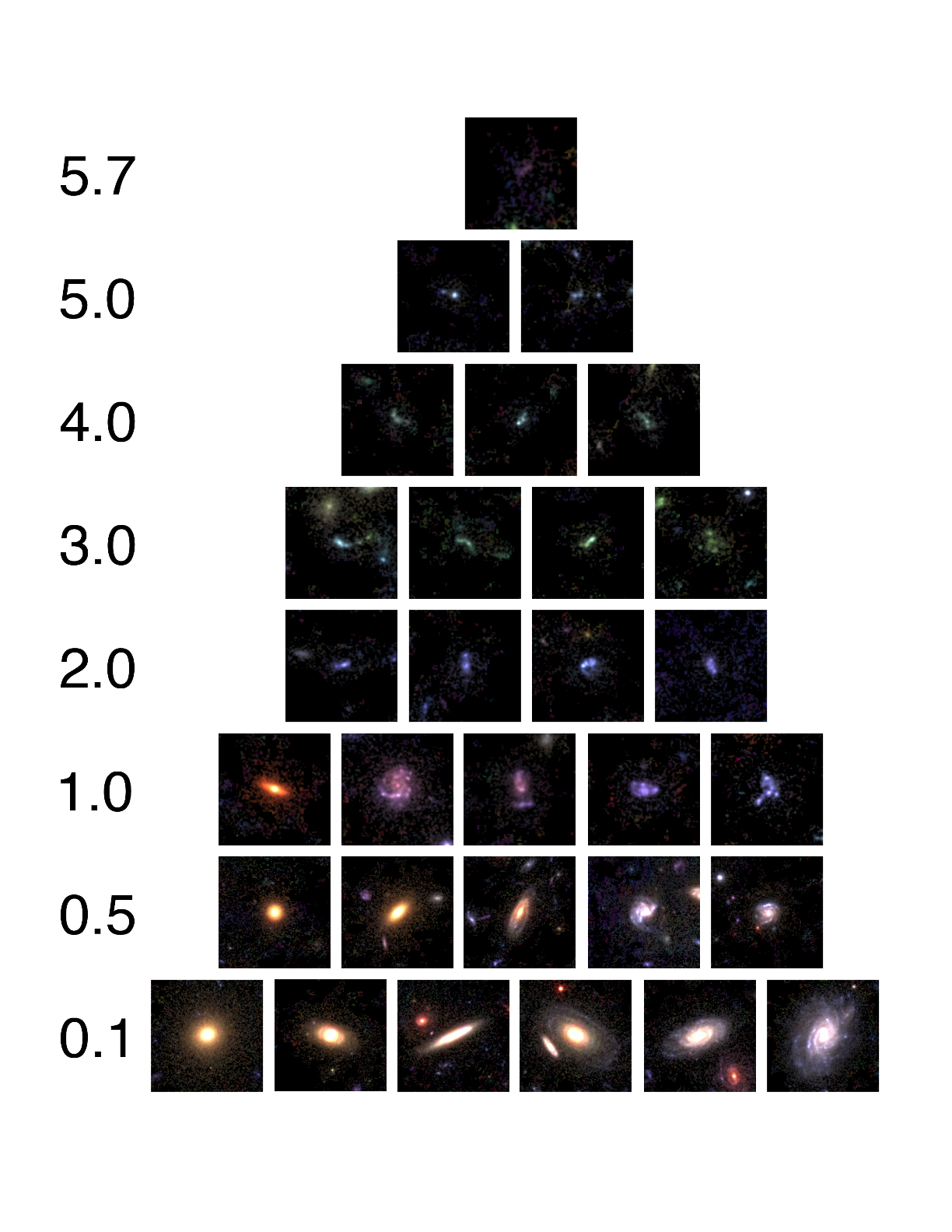
|
These galaxies drawn from the Cosmic Evolution Survey (COSMOS) illustrate the buildup of structure over cosmic time. Each row of galaxies is labeled by redshift (distance), from nearby galaxies at redshift 0.1 to an extremely distant galaxy beginning to form at redshift 5.7. Image Credit: P. Capak (SSC) and the COSMOS team. |
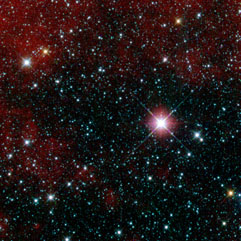
|
This infrared snapshot of a region in the constellation Carina near the Milky Way was taken shortly after NASA's Wide-field Infrared Survey Explorer (WISE) ejected its cover. The "first-light" picture shows thousands of stars and covers an area three times the size of the Moon. Over the course of the mission, WISE will take more than a million similar pictures covering the whole sky. The initial WISE data release at IRSA is scheduled for Spring 2011. This eight-second exposure shows infrared light from three of WISE's four wavelength bands: Blue, green and red correspond to 3.4, 4.6, and 12 microns, respectively. Image Credit: NASA/JPL-Caltech/UCLA |
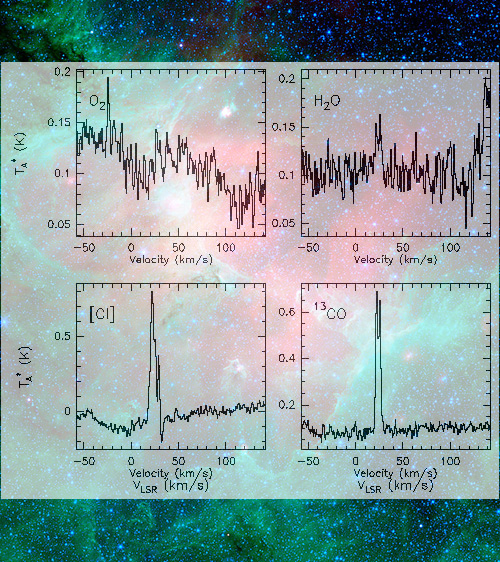
|
Spectra of carbon, water, molecular oxygen, and carbon monoxide in the Eagle Nebula (M16) were observed by the Submillimeter Wave Astronomy Satellite (SWAS). A Spitzer color composite of 4.5 micron (blue), 8 micron (green), and 24 micron (red) data from the GLIMPSE and MIPSGAL Legacy projects is shown in the background. Image credits: SWAS Team (Harvard-CfA); N. Flagey, A. Noriega-Crespo (SSC). |
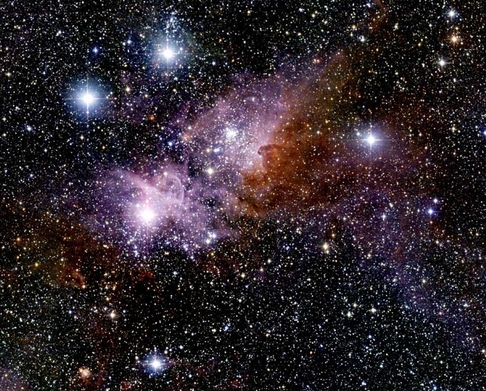
|
The Keyhole Nebula in Carina, as seen by 2MASS. Eta Carinae, in the lower left portion of the nebula, is one of the most massive stars known in the Milky Way at around 100 Solar masses. Image credit: 2MASS/G. Kopan (IPAC). |
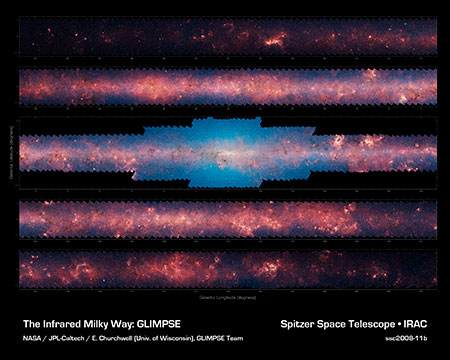
|
An infrared portrait of the Milky Way - from top to bottom the panels of this mosaic image cover more than 50% of the Galaxy. The data were taken as part of the Galactic Legacy Infrared Mid-Plane Survey Extraordinaire (GLIMPSE) project. In this four-color composite, blue is 3.6 microns, green is 4.5 microns, orange is 5.8 microns, and red is 8.0 microns. Image credit: NASA/JPL-Caltech/E. Churchwell (University of Wisconsin). |
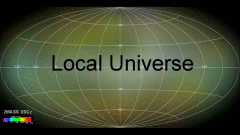
|
Large scale structure in the local Universe (out to a redshift z=0.2) in the 2MASS XSCz catalog, derived from the 2MASS Extended Source Catalog (XSC). Different colors represent galaxies at different distances. Credit: Tom Jarrett (IPAC). |
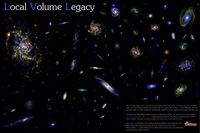
|
Galaxies in the Local Volume Legacy survey (LVL), a study of 258 of the nearest galaxies. In these three-color images, 3.6 um emission is blue, 8 um emission is green, and 24 um emission is red. Credit: Shawn Staudaher (U. Wyoming) and the LVL team. |
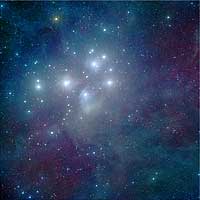
|
Known throughout the world under various names -- Subaru to the Japanese, Matarii ("Little Eyes") to the natives of Tonga, Athur-ai ("The Stars of Hathor") to the ancient Egyptians -- the Pleiades (as it was known to the ancient Greeks) is a cluster of naked-eye stars located in the constellation Taurus, the Bull. This cluster is now known to be a collection of relatively young stars, their births having occurred only 100 to 125 million years ago. The brightest stars shown here are those visible to the naked eye on a clear winter's night and represent hot blue giants much more massive than our Sun; the faintest members of the cluster are faint red dwarfs only a tenth of the Sun's mass. The blue, green, and red channels of this three-color image were made from B-, R-, and I-band images, respectively, from the Digitized Sky Survey. Image courtesy of Inseok Song (U. Georgia) and created with Montage v3.0 using this script. |
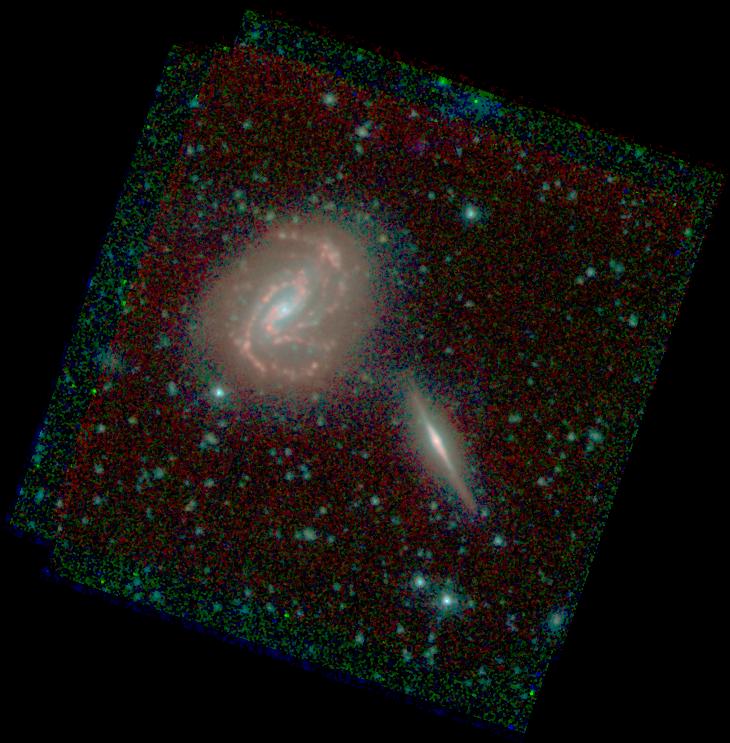
|
The interacting galaxy pair NGC 877 (face-on) and NGC 876 (edge-on) as seen by the GOALS Spitzer Legacy Project. This false-color view is made from IRAC 3.6 (blue), 4.5 (green), and 5.8 (red) um images. |
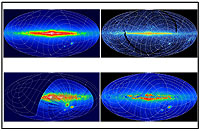 |
Density maps for four all-sky or large-area catalogs served by IRSA: the 2MASS All-Sky Point Source Catalog, the IRAS Point Source Catalog, the DENIS 3rd Release Catalog, and the USNO-B1.0 Catalog. These catalogs can be searched using the IRSA general search engine. |
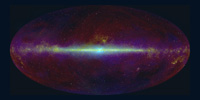 |
An Aitoff projection in Galactic coordinates showing two IRSA archived data sets. The blue and green image components represent the sky as seen by 2MASS at J and Ks bands; these have been combined with a red/yellow image of the IRAS/COBE 100 micron data from Schlegel et al. (1998). To give positional context, the brightest 2000 stars at V band have been added as white dots. |
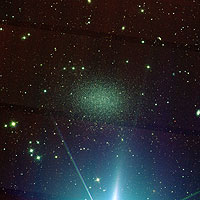 |
Located just north of Regulus (seen as the bright spray off the bottom of the image), the Leo-I galaxy is a dwarf spheroidal satellite galaxy to our own Milky Way and is the most distant of the fifteen Milky Way satellites known. This three-color view spans a 0.5x0.5-degree region and was created from 45 separate images from the Sloan Digital Sky Survey. The SDSS g-, r-, and i-bands map to the image's blue, green, and red channels, respectively. The mosaic was created with the IRSA On-Demand Image Mosaic Service and Montage v3.0. |
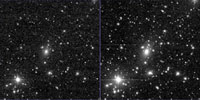 |
Side-by-side comparison of the 0.2 x 0.2 degree J-band mosaics of Abell 3558 from (left) the main survey Atlas and (right) the full survey image archive. The full survey atlas has about 17 repeated scans on the B cluster core. The on-request image mosaic service has been extended to support mosaics of the 2MASS All Sky Atlas and of the 2MASS Full Survey Image Atlas. |
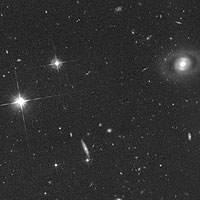 |
A 2x2 arcminute field centered at J2000 coordinates 09:58:48.04 +02:02:28.0 in the Cosmic Evolution Survey (COSMOS) field. This image is a cutout of the Hubble Space Telescope Advanced Camera for Surveys mosaic acquired in the F814W (roughly I-band) filter. All COSMOS data that have been released to the public are available through IRSA. |
 |
The Statistics Service for the 2MASS All-Sky Point Source Catalog provides quick estimates of the number of 2MASS sources that lie within a given radius of a sky location. It also provides plots and tables of magnitude and color distributions for sources in the region — the plots on the left compare the J-H (red), H-Ks (green), and J-Ks (blue) color histograms for an area well out of the Galactic plane (top) to the same distributions for a field along the plane (bottom). |
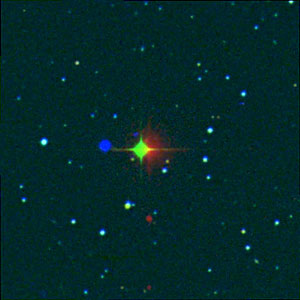 |
A 5-arcminute square view around the exoplanet host star, Gliese 581, using data provided by FinderChart and combined into a three-color image by Montage. DSS1 Bj-band, DSS2 R-band, and 2MASS J-band images are color coded as blue, green and red, respectively. Not only is the high motion of Gliese 581 itself obvious over the three epochs (1955, 1991, and 1999), but also obvious are artifacts in the DSS1 and 2MASS image sets (click on image for annotations) and an unrelated (and uncataloged?) star of smaller proper motion to the south-southeast of Gliese 581. For more data sets on the exoplanet host star, see the IRSA-Vizier inventory service. |
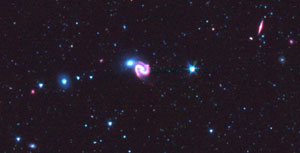 |
A small portion of the Chandra Deep Field South region as taken by the Spitzer Wide-area InfraRed Extragalactic Survey (SWIRE) Legacy Project. This 3-color jpeg preview image is a mosaic of IRAC channels 1, 2, and 4 where the 3.6, 4.5, and 8.0 micron data are color coded as blue, green, and red, respectively. Science products from this and other Spitzer Legacy Programs can be found in the Spitzer section of the IRSA holdings. |
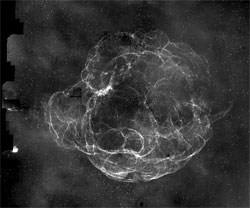 |
A continuum-subtracted H-alpha image mosaic of the supernova remnant S147, constructed using Montage. The total imaged area is roughly 5 x 3.5 square degrees. The bright "blob" to the left of the picture is a more typically compact Galactic nebula. Credit: Isaac Newton Telescope (INT) Photometric H-alpha Survey of the Northern Galactic Plane; Albert Zijlstra, University of Manchester; Jonathan Irwin, IoA Cambridge. |
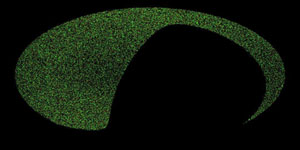 |
An Aitoff projection in Galactic coordinates showing sky coverage for the proper motion survey of Lepine et al. (2005, the LSPM-North Catalog). This and hundreds of other catalogs can be explored using the NVO Quick Sky Statistics service, hosted at IRSA. The service generates source counts, coverage maps, and links to downloadable data for all catalogs at IRSA, NED and CDS VizieR. |
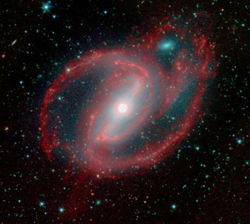 |
The SBb LINER galaxy NGC 1097 as taken with the Infrared Array Camera (IRAC) onboard the Spitzer Space Telescope. This image, part of the Spitzer Infrared Nearby Galaxy Survey (SINGS), is a three-color mosaic preview comprised of 3.6 um (blue), 4.5 um (green), and 8.0 um (red) data. Science products from this and other Spitzer Legacy Programs can be found in the Spitzer section of the IRSA holdings. |
 |
| This three-color mosaic of part of the Galactic Plane represents a tiny portion of the GLIMPSE data available through IRSA. GLIMPSE (the Galactic Legacy Infrared Midplane Survey Extraordinaire) is a Spitzer Legacy Science Program that is surveying the inner portion of the Milky Way Galaxy. This and other Spitzer Legacy Science products can be found in the Spitzer section of the IRSA holdings. |
